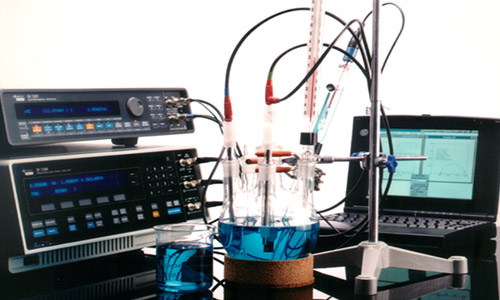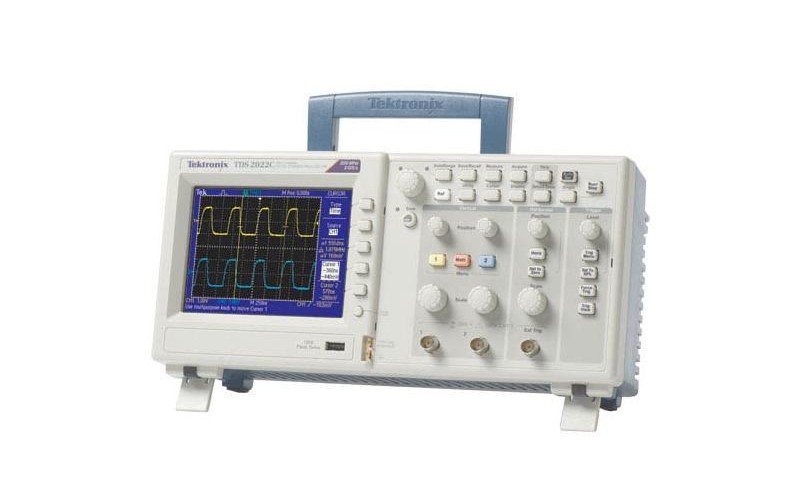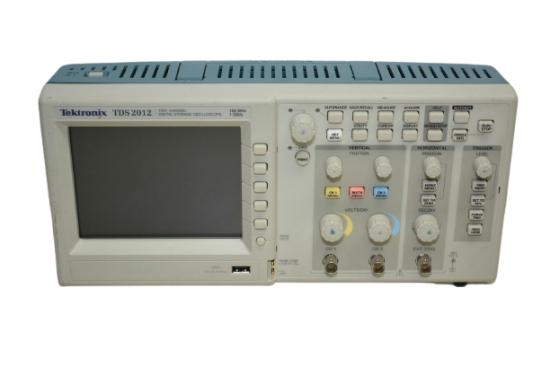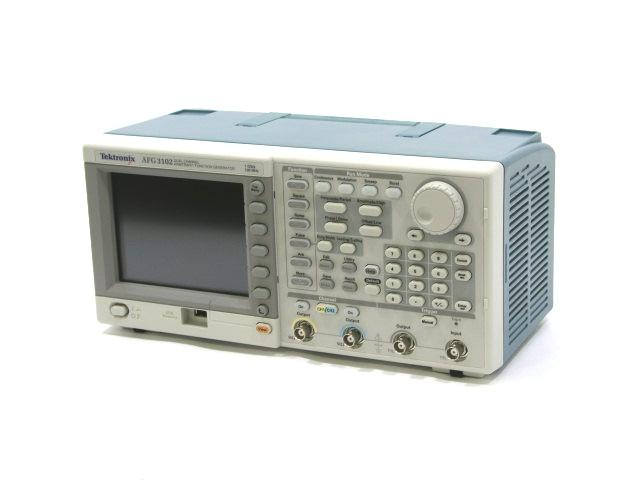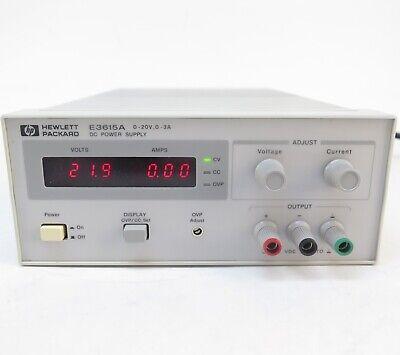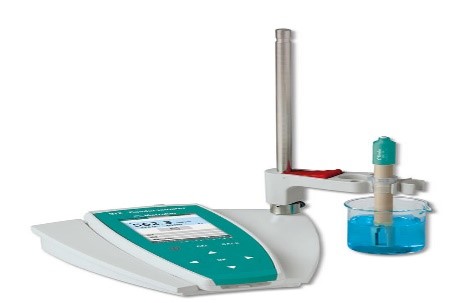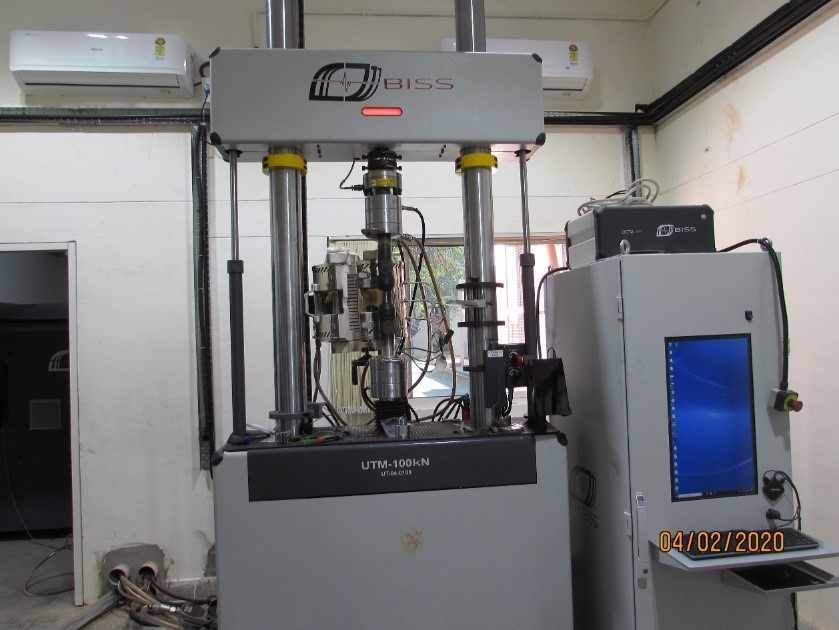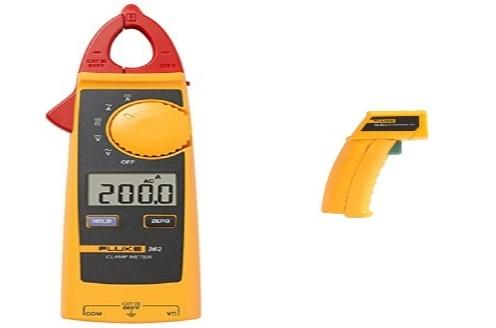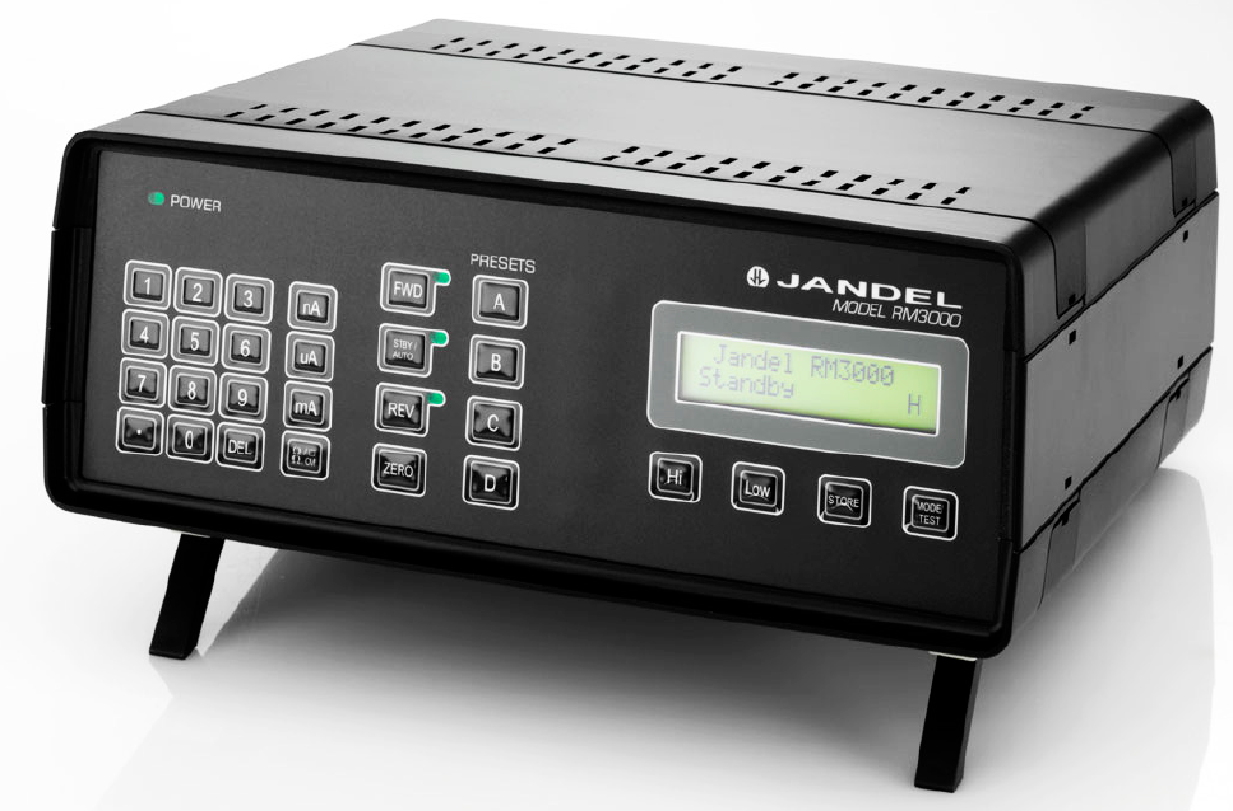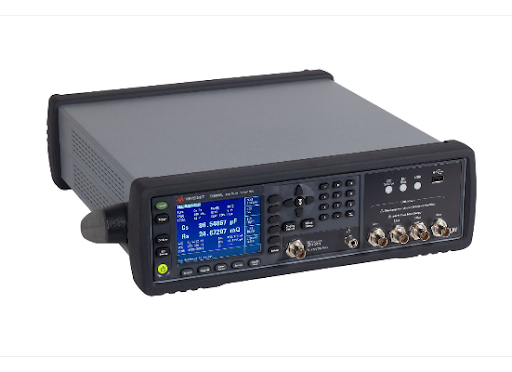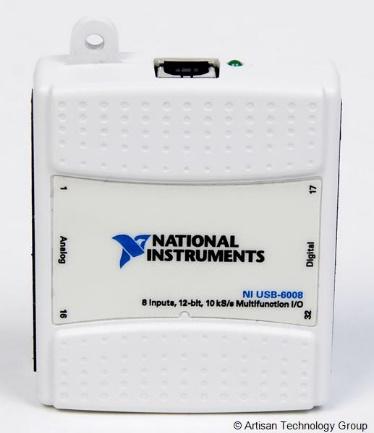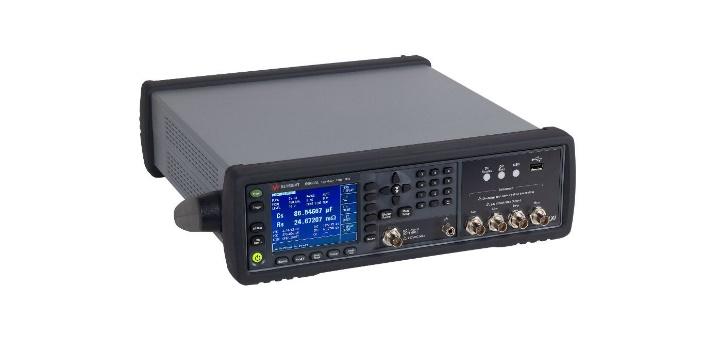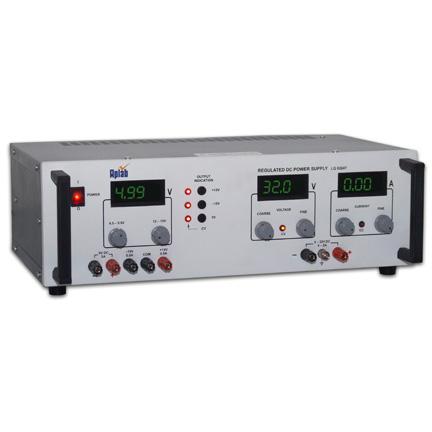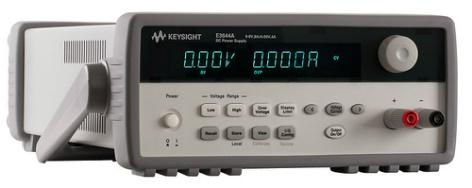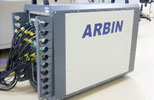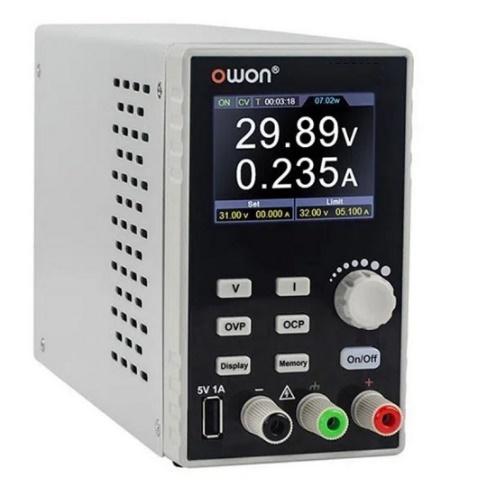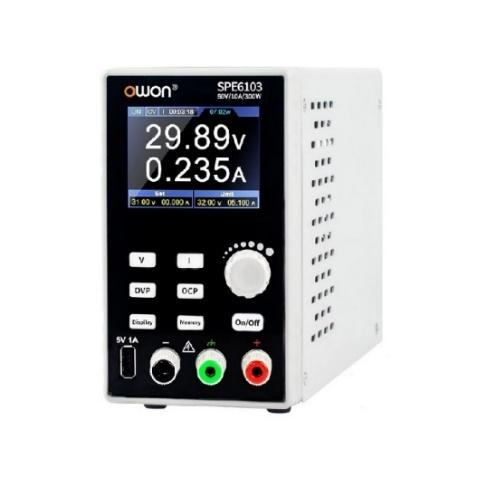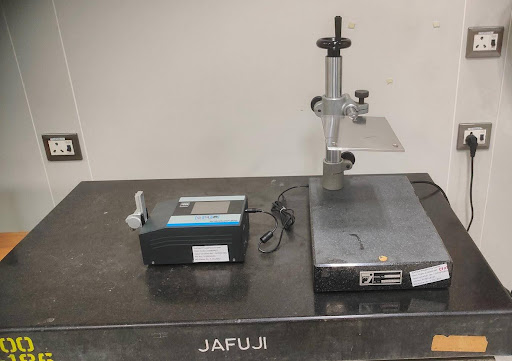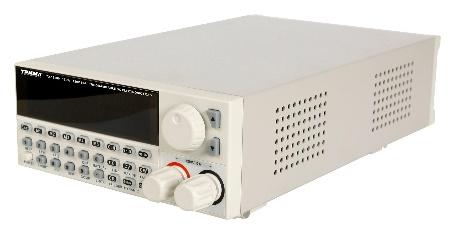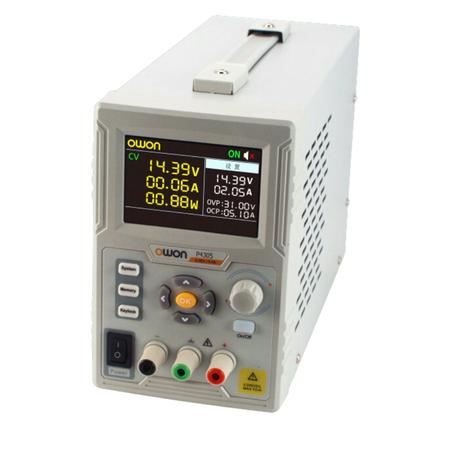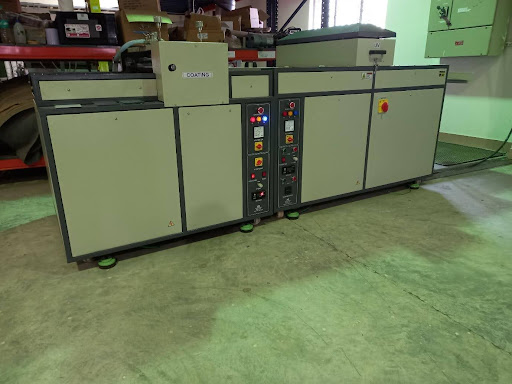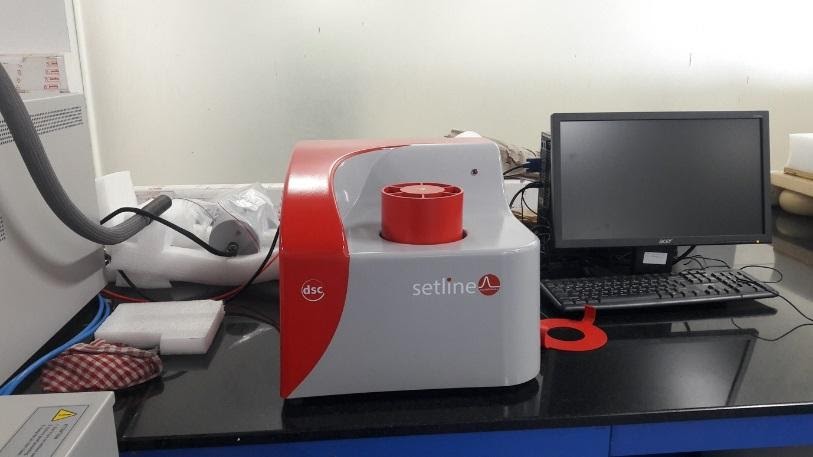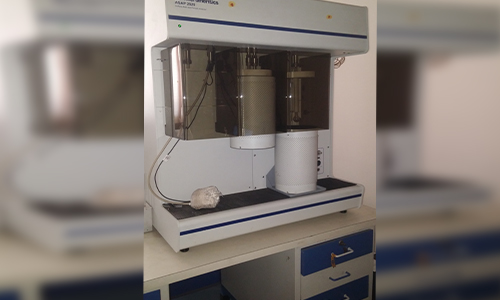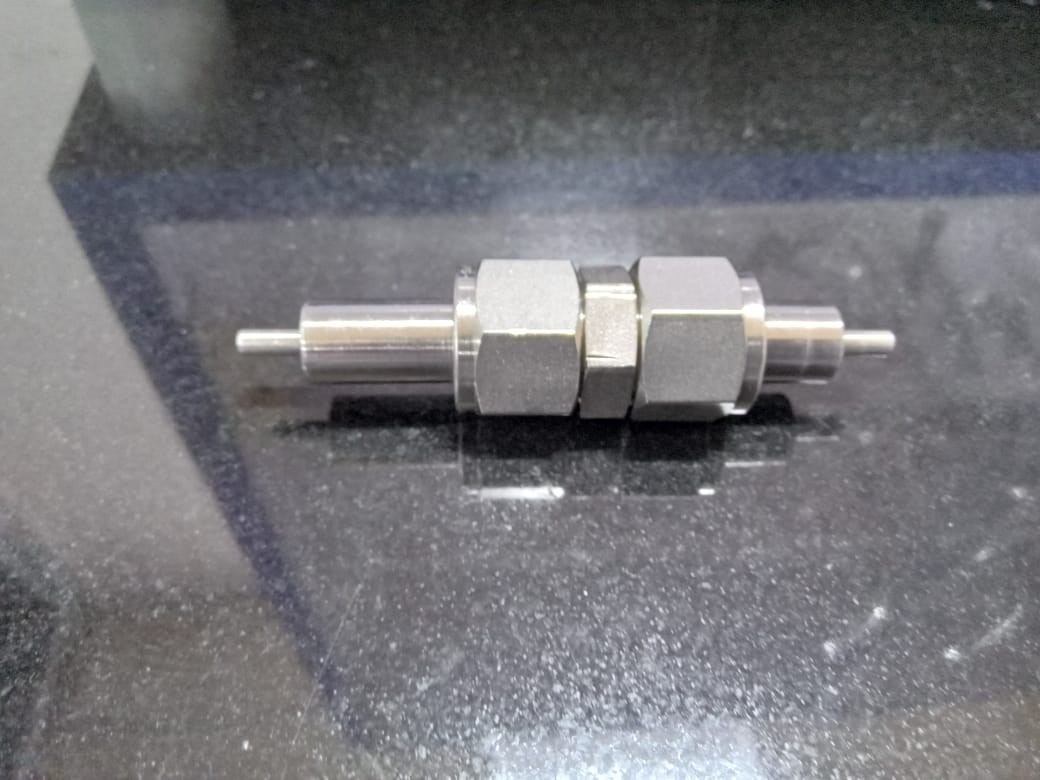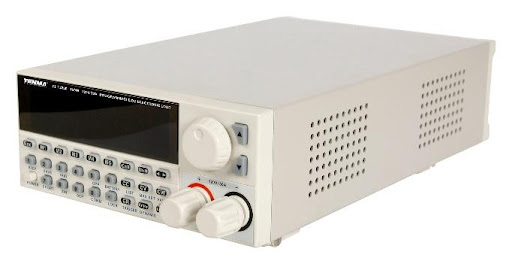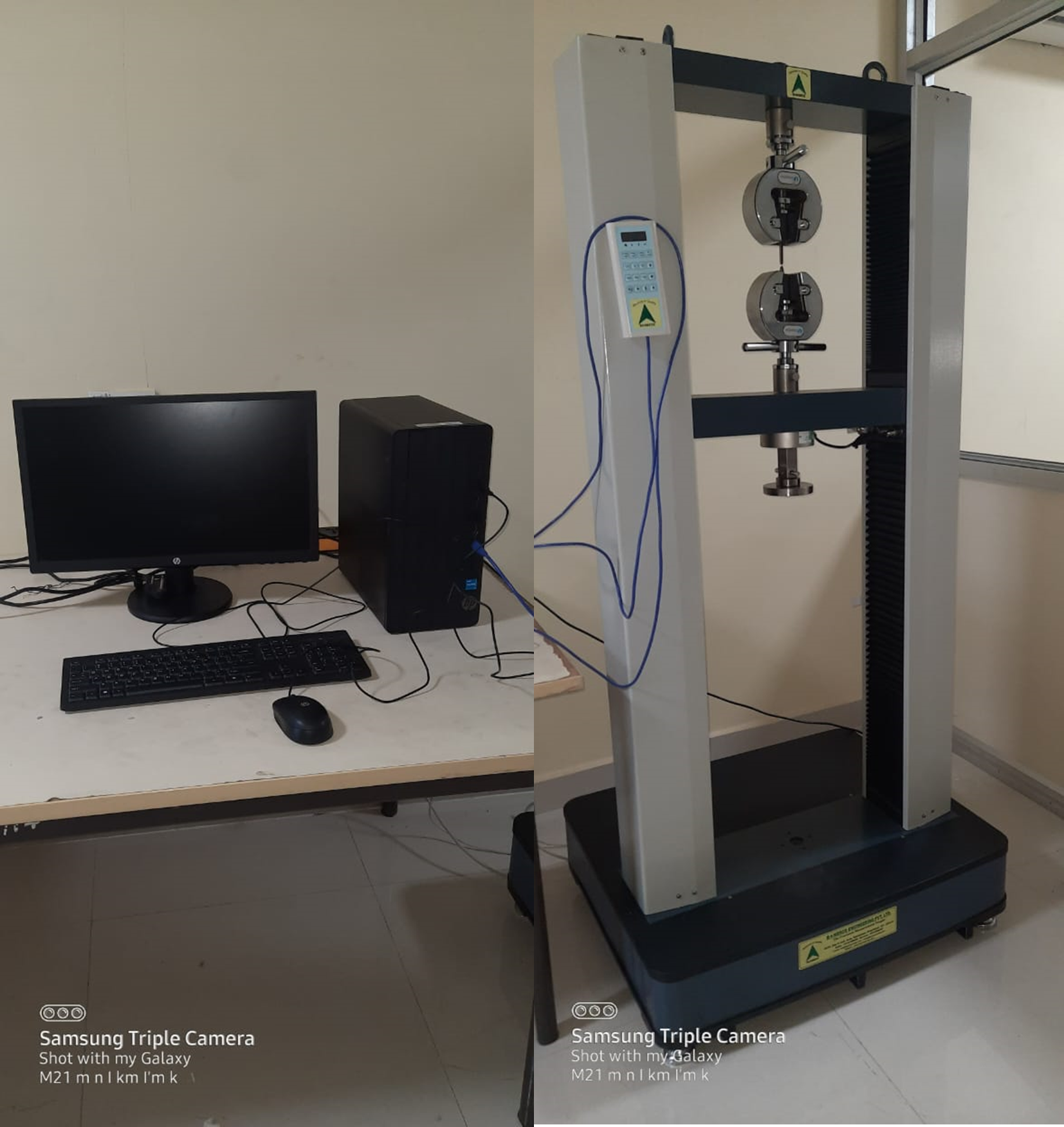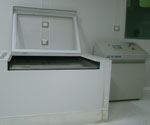Characterization
3 channel Potentiostat/Galvanostat with RRDE
Model and Make
- VSP, Biologic Science Instruments
Specifications
- Current range: 10 µA up to 0.4A (760 pA resolution)
- 20 V adjustable reference voltage
- Resolution: 300 µV programmable down to 5 µV by adjusting the dynamic range
- Acquisition time: 200 µs
- Simultaneous EIS measurement
Details
The VSP provided with three channels is supplied with EC-Lab software package. The VSP chassis is designed to receive +/-10 A current booster option. The VSP can be outfitted with potentiostats capable of performing Electrochemical Impedance Spectroscopy (EIS).The frequency range is from 10 µHz to 1 MHz. Over 70 techniques can be sequenced, and with a variety of analysis tools, including EIS modeling with Levenberg Marcquardt and Simplex algorithms. Suitable for most electrochemical studies including corrosion studies, battery testing and intercalation compounds study.
33120A Hewlett Packard
Model & Make
33120A, Hewlett Packard
Specifications
- 15 MHz sine & square waveforms Ramp, triangle, noise & DC waveforms
- 12-bit, 40 MSa/s, 16,000 points arbitrary waveforms
- AM (int/ext), FM (int), FSK (internal/external), burst (int/extl)
- Linear & logarithmic sweeps and burst operation
- IntuiLink software plus GPIB & RS-232 interfaces included
- Option 001 provides improved stability & a multiple-unit link
Details
Used for testing and troubleshooting electronic circuits and simulating signals from different devices
Centre
Electronics and Instrumentation
3D Printing of Enclosures for control circuits
3Utilizing the Ender Pro 3D printer, our team has streamlined the process of fabricating enclosures for embedded control system circuits developed in-house. With its precise printing capabilities and reliable performance, the Ender Pro has become an indispensable tool in our prototyping and production workflow. By seamlessly translating digital designs into physical enclosures, we can swiftly iterate and customize housing solutions tailored to the unique specifications of our control systems. This integration of 3D printing technology not only enhances efficiency but also empowers innovation, enabling us to rapidly bring our ideas from conception to reality with precision and ease.
Creality Ender-3 Pro specifications
- Company: Creality
- Technology: FFF FDM
- Printer type: Filament deposition
Materials
Build size (XYZ)
Properties
Requirements
Centre
Electronics and Instrumentation
Ac/Dc Soft/Hard B-H Loop Tracer
Model & Make
AMH-20K-HS, Laboratorio Elettrofisico Engineering srl., Italy
Specifications
- Frequency range DC to 20 kHz,
- Embedded coil set up to measure properties of irregular hard magnetic samples
- High temperature set up to measure properties up to 200oC.
- Simultaneous measurement of core loss, coercivity, permeability & saturation induction.
Details
Used for measuring engineering magnetic parameters like induction, core loss, coercivity, permeability both in AC and DC conditions
Centre
Centre for Automotive Energy Materials
Accelerated Rate Calorimeter (ARC)
Model and Make:
ARC BTC 500 & Hazards Evaluations Labs (HEL), UK
Specifications
- Chamber size - 1 x 1 x 1 m
- Chamber make – Stainless steel body of 20 mm thick
- Complete Adiabatic controlled chamber
- Withstanding pressure range – 2 to 5 bar
- Temperature measurement – Direct sample contact
- Exotherm sensitivity – 0.005 to 0.02 °C/min
- No of heaters and temperature sensors – 6 numbers
- Temperature range of tracking – 500 °C
- Infra-red camera for thermal imaging
- Nail penetration apparatus is attached
- Gas sampling can be done
- Cooling coil permits to carry low temperature testing
Details
- Determination of thermal runaway “onset” temperature (Heat-Wait-Search)
- Determination of maximum safe discharge current leading to thermal runaway
- Determination of maximum over-voltage, leading to thermal runaway
- Nail penetration
- Short simulation
- Specific heat capacity of cells/battery
Centre
Centre for Automotive Energy Materials
Accelerated surface area pore analyser
Model & Make
ASAP2020; Micromeritics, USA
Specifications
Consists of two ports , one for vacuum and One for analysis with three transducers in the range 0-1,1-10 and 10-1000 mm of Hg, capable of measuring single and multi-point surface area, Adsorption-desorption isotherms, Micropore, Size distribution, meso and macro pore area, total pore volume, physisorption and chemisorption from room temperature to 450oC, standard software for automated operation
Details
The instrument is capable of measuring the surface area and pore size distribution from 3Ao to 5000Ao with the help of various analysis gases like N2, Ar, CO2,O2,Kr, Co and any non-corrosive Gases.
Centre
Centre for Fuel Cell Technology
Additive Manufacturing - Electron Beam Melting
Specifications
- Electron Beam Power: 3000 W
- Build volume: 200mm x 200mm x 380mm (W x D x H)
- Cathode type Tungsten filament
- Max. EB translation speed 8,000 m/s
- High process temperatures: upto 11000C
- Vacuum Process
- Open software for process development
- Lower residual stresses
Applications:
- Reactive and refractory alloys such as Ti alloys, TiAl, C103 etc
- Ideal for orthopedic implants
- Mesoporous structure
- Components with complex designs
- Aerospace components
Arc Melting Unit
Model & Make
AM 133, Vacuum Systems & Technology, Israel
Specifications
- Melting capacity of up to 500 grams
- High frequency arc starter
- Programmed inert atmosphere control maintaining constant pressure
- Programmable power and pressure control
- Temperature: over 3400 0C
Details
Used for melting of alloys
Centre
Centre for Automotive Energy Materials
Arduino MEGA 2560
Model Arduino UNO& Make
Arduino UNO
Specifications
- ATmega2560 microcontroller
- Operates at 5V
- 54 digital I/O pins (15 PWM)
- 16 analog inputs
- 256 KB of flash memory
- 8 KB of SRAM
- 4 KB of EEPROM
- 16 MHz clock speed
- Supports UART, I2C, and SPI communication
Details
Used for projects that require many I/O pins, such as automation, and sensor networks.
Centre
Electronics and Instrumentation
Atomic Force Microscopy (AFM)
Model and Make
- Park XE7 (Direct On-Axis Manual Focus Optics)
Specifications
- XY Sample stage : 13 mm x 13 mm
- Scan Range in XY : 50 µm (max)
- Scan Range in Z : 12 µm (max)
- Options : Non Contact, Contact, Dynamic Contact, Phase Imaging. Heater Stage and Lithographic.
Details
The atomic force microscope (AFM) is extensively used in material science and biological sciences. Characterization of sol-gel thin film surface morphology in sub-micron scale is necessary to evaluate their function properties in a wide variety of applications. It has been known that sub-micron and nanoscale properties control various aspects of functional performance. For example, enhanced transmittance in borosilicate glass (BSG, 91%) over soda lime glass (SLG, 89%) is due to sub-nanometer surface morphology of BSG. This may occur due to its different chemical composition though the refractive indices are comparable.
Attenuated Total reflectance (ATR) facility
Model and Make:
Bruker, VERTEX 70v vacuum FTIR, USA
Specifications
- spectral range = 50 to 6000 cm-1
- ambient = ultrahigh vacuum
- mode = reflection and transmission
- Spectral = resolution 0.4 cm-1
Details
The instrument is useful for identification of functional groups in the sample and also with quantitative estimation.
Centre
Centre for Automotive Energy Materials
Battery Test Equipment
Model & Make
BT-2000, Arbin Instruments
Specifications
- Serial No: 166347
- Dimensions (W xL xH, inch): 14 x30 x25
- Channels: 20 Nos.
- Current range:
- Low: -100 µA ~ 100 µA
- Medium: -0.0005A ~ 0.0005A
- High: -0.005A ~0.005A
- Voltage Range: 0 V ~ 10 V
- Maximum Power: 0.05 W
Details
Arbin Instruments BT-2000 is a multi-channel testing system designed for R& D and production of batteries and other electrochemical energy storage devices. Each channel operates independently of each other enabling users to run tests on multiple batteries at the same time.
The features of Arbin Instruments BT-2000 are (i) completely independent channels allow users to run multiple independent tests simultaneously without affecting the other channels, (ii) accuracy up to 0.02% for low power and 0.05% for high power applications, (iii) Potentiostatic/Galvanostatic stations fine-tuned for battery Research & Development, and (iv) Up to three current ranges per station available for improved accuracy over a wide range of testing conditions.
Centre
Centre for Nanomaterials
Battery Testing Equipment (2 nos)
Model & Make
Arbin BT 2000, USA
Specifications
- Number of Channels: 32
- Current Range: 100 µA to 5 A
- Voltage: 0-10 V
- Temperature: -200 to 400 0C
Details
To measure voltage, capacity, cycle life, cycle stability, columbic efficiency of Lithium ion cells
Centre
Centre for Automotive Energy Materials
Bench Grinding Machine
Model Make
Specifications
- Sharpening tools like chisels, blades, and drill bits
- Grinding and shaping metal or other hard materials
- Polishing or buffing surfaces with appropriate attachments
- Deburring edges and removing rust or paint
- Tool maintenance in workshops and industrial settings
Centre
Electronics and Instrumentation
Bench top drilling machine
Model Make
Ralli Wolf SD4C Light Duty Drill
Specifications
- Power Input: 435 Watts
- Chuck Capacity: 13 mm
- No-Load Speed: 700 RPM
- Weight: Approximately 4.5 kg
- Body Construction: Aluminium die-cast
- Design: Dual-handle configuration for enhanced control
Details
Used for light drilling in wood, metal, and small workshop or repair jobs
Centre
Electronics and Instrumentation
BET Surface Analyzer
Model & Make
(11-2370)Gemini, Micromeritics, USA
Specifications
- Surface area determination limits : 0.1 m2 to >300 m2
- Sample quantity : Sample capacity is approximately 2.0 cm3
- Temperature : 10 to 350oC operating, 0 to 50oC non-operating
- Humidity : 20 to 80 % relative, non-condensing
- Gases : Optimized for nitrogen in a liquid nitrogen sample bath. Typically, oxygen, argon, butane, Methane and other light hydrocarbons.
Details
Surface area and porosity are important characteristics, capable of affecting the quality and utility of many materials. For this reason it is important to determine and control them accurately. BET theory of physical adsorption to form a monolayer of gas molecules on a solid surface is the basis for measurement of the specific surface area. The salient features are low surface area measurement capability up to 0.01 m2/gm with nitrogen, measurement of pore volume < 4.0 to 10-6cc/gm and higher, automatic free space correction unique twin tube design, data capability of single and multi point BET surface area.
Centre
Centre for Nanomaterials
Break Down Voltage Tester (DC and AC)
Model & Make
Custom made
Specifications
- Voltage rating for AC: 0-10kV±0.02
- Current rating for AC: 0-100m±0.02
- Voltage rating for DC: 0-5kV±0.02
- Current rating for DC: 0-50m±0.02
Details
The system can be used to measure the resistivity of the materials by changing current and voltage.
Centre
Centre for Nanomaterials
C-S Analyzer
Model & Make
CS - 444, LECO, USA
Specifications
- HF-400 induction furnace (18 MHz, 2,2 kW) for CO2/SO2 conversion
- Measured carbon in the range 0 to 0.5 %,
- Measures sulphur in the range 0 to 0.35 %
Details
Carbon/Sulphur system is a microprocessor based software driven instrument for wide range measurement of Carbon and Sulphur content of metals, ores, ceramics and other inorganic materials. It uses HF-400 induction furnace (18 MHz, 2,2 kW) for CO2/SO2 conversion. It works on the principle of infrared absorption of CO2 and SO2.
Centre
Centre for Nanomaterials
Calendering Machine
Model & Make
IMC, USA
Specifications
- Compressed Air: 6 bar
- Line speed : 0 - 5 m/min
- Hydraulic Press Load: 0-1034 bar
- Rewind and Unwind Tension: 0.1-5 kg
- Nip gap adjustment: 1m
- Pre-heat Temperature : 20-150o C
Details
To prepare compact and high density electrodes thereby maximizing the cell capacity and rate performance
Centre
Centre for Automotive Energy Materials
Calo Tester
Model & Make
PLATIT
Details
Calo tester is used for making calo's of known diameter especially used for measuring thickness of any thin film. The Calo tester uses ball grinding mechanism employing a known diameter steel ball for making a calo on the test sample surface. The minimum thickness that can be measured depends on the dimensions of the ball used. The calo generated from the tester is then monitored using an optical microscope connected to a computer having software (based on simple trigonometry principles) for thickness calculation.
Centre
Centre for Engineered Coatings
Capillary Flow Porometry
Model & Make
Porolux 1000; Porometer, Belgium
Specifications
- Operates with pressure transducers upto 35 bar
- Minimum pore size measurements: down to 18 nm.
- LabVIEW software
Details
Capillary flow Porometry is based on the displacement of a wetting liquid inside a porous network by means of an inert gas flow. With Porometry through pores inside a sample are characterised. Through pores are open on both sides of a filter or a membrane and therefore determine the functionality. The important parameters such as largest pores, the mean flow pore size and smallest pores of the sample can be determined.
Centre
Centre for Fuel Cell Technology
Carbon-Sulphur Analyzer
Model and Make
- CS - 444, LECO, USA
Specifications
- HF-400 induction furnace (18 MHz, 2,2 kW) for CO2/SO2 conversion
- Measured carbon in the range 0 to 0.5 %,
- Measures sulphur in the range 0 to 0.35 %
Details
Carbon/Sulphur system is a microprocessor based software driven instrument for wide range measurement of Carbon and Sulphur content of metals, ores, ceramics and other inorganic materials. It uses HF-400 induction furnace (18 MHz, 2,2 kW) for CO2/SO2 conversion. It works on the principle of infrared absorption of CO2 and SO2.
CLAMP METERS
Model & Make
FLUKE 325 TRUE RMS CLAMP METER
Specifications
- Current Measurement: AC/DC up to 400 A
- Voltage Measurement: AC/DC up to 600 V
- Resistance: Up to 40 kΩ with continuity detection
- Capacitance: 100 μF to 1000 ΜF
- Frequency: 5 Hz to 500 Hz
- Temperature: -10°C to 400°C (14°F to 752°F)
- True RMS: Accurate readings on non-linear loads
- Display: Large, backlit for easy readability
- Safety Ratings: CAT III 600 V, CAT IV 300 V
- Design: Slim, ergonomic for one-handed operation
- Additional Features: Data hold, min/max recording, auto-ranging
Details
Used for electrical troubleshooting, HVAC maintenance, industrial equipment testing, and general electrical system maintenance
Centre
Electronics and Instrumentation
Coercimeter
Model & Make
CR-02; Laboratorio Elettrofisico Engineering srl., Italy
Specifications
- Measurable coercivity range 0.012 to 125 Oe,
- Can measure coercivity of irregular samples
- Maximum field resolution 1x10-3 Oe.
- Measuring accuracy ±1%
Details
Used for measuring coercivity of soft magnetic materials
Centre
Centre for Automotive Energy Materials
Confocal Micro-Raman Spectrometer with Mapping Facility
Make
Witec
Model
WITec UHTS 600
Specifications
- Laser Sources: 532 nm and 633 nm
- Raman spectral imaging: acquisition of a complete Raman spectra at every image pixel
- Planar (x-y-direction) and depth scans (z-direction) with manual sample positioning
- Image stacks: 3D confocal Raman imaging
Details
The Confocal Raman Microscope contains a compact and flexible platform optimized for high-end spectroscopy applications and confocal Raman imaging consisting of a research grade optical microscope with 6x objective turret, video CCD camera, LED white-light source for Köhler illumination, manual sample positioning in x- and y-direction and fibre coupling.
Centre
Centre for Nanomaterials
Contact Angle Measurement Unit
Model and Make
- DSA25 with temperature-controlled chamber, KRUSS, Germany
Specifications
- Zoom – 6.5 x, Manual
- Camera performance – 2000 fps at 90 x 60 px
- Dosing – Software Controlled
- Resolution – 0.1 µL with Glass syringe
- Tilting - External, 0-90°
- Temperature controlled chamber (-10 to 130 °C)
Details
Contact angle measurement gives an idea about the wetting ability of a material. The material can be metallic, non-metallic, coated or surface treated. Measured volume of a drop of liquid (in most cases, distilled water) is placed over the surface and the wetting ability is recorded by measuring the angle subtended by the drop on the surface of the material. This gives an idea about, the material, whether it is hydrophilic or hydrophobic in nature. Surface free energy of the solid can also be determined by making use of the contact angle measurements.
Corrosion Testing Facility
A. Cycling Corrosion Cabinet
Model &Make
CCX 2000, Atlas Material Testing Solutions, USA
Specifications
Details
To better understand the potential for adverse effects of outdoor exposure, materials are regularly tested to various environmental conditions. The cyclic corrosion cabinet is now accepted as superior at duplicating actual environments. It improves repeatability, reduces time spent in handling samples and also operator error by creating different environments in one cabinet. Standard exposure cycles like salt or chemical fog, water fog, salt spray, dry-off cycle, high temperatures i.e. up to 70oC can be increased for required time from hours to number of days which are closer to environmental changes.
Salient features-Materials of different sizes and shapes can be tested under various environmental conditions by using various standard methods like ASTM B117, ASTM G85 A5, CCT I, CCT IV, SAE J2334 and GM9540B.
B. Electrochemical Corrosion Testing Equipment
The electrochemical testing system consists of two units. Electrochemical interface and impedance/gain-phase analyzer along with softwares corroware and Z plot
a) Electrochemical Interface
Model & Make
SI1287-Solartron, U.K
Details
The corrosion is an electrochemical process and electrochemical potential is the driving force for reactions. The principle employed in the electrochemical interface is based on the application of a controlled voltage to a sample (working electrode) and measurement of the change in current, or vice versa. The corrosion rates of the specimens can be determined using CorrWare programme. Most of the corrosion types uniform, localized, galvanic, dealloying; stress corrosion and hydrogen-induced failure can be analyzed by this technique. Conventional electrochemical experiments like static, dynamic polarization, potentiostatic, potentiodynamic experiments etc. can be done. This system is extensively used to study the corrosion properties of coated substrates. Based on the results, further improvement of coatings has been done. Different types of coatings like DLC on Al alloys, MAO coatings on Al, Coating on steels and Al alloys by Sol-Gel technique, materials like Mg-Zn, steels, alloys have been analyzed. The system can also be used to study batteries, fuel cells, inhibitors, electroplating and catalytic properties etc.
b) Impedance/Gain-Phase Analyzer for EIS
Model & Make
SI1260-Solartron, U.K
Specifications
Frequency range 10 µHz to 32 MHz with 10 µHz resolution.
Details
Electrochemical Impedance Spectroscopy is a powerful technique, which can provide lot of information on corrosion reactions, mass and charge transport, the characteristics of material and coating in different electrolytes. An electrode interface undergoing an electrochemical reaction is typically analogous to an electronic circuit consisting of a specific combination of resistors and capacitors. This is used to characterize the electrochemical system in terms of its equivalent circuit. The system is widely used in characterization of materials, batteries, and coatings and to illustrate their corrosion mechanism. It is also used for investigating mechanisms in electrodeposition, electrodissolution, passivity and corrosion studies.
Centre
Centre for Material Characterization and Testing
Cross Hatch Adhesion Tester
Model and Make
- Elcometer 107, ELCOMETER, USA
Specifications
- Cutter type - 6 x 1 mm
- Coating thickness - 0 to 60 µm / 0- 2.4 mils
- Adhesive tape - ASTM standard [ASTM D3359]
Details
Cross hatch adhesion test, or simply, tape test in one of the standard tests to rate the adhesion of coating on a material. Lattice pattern of cut is generated by the cutter by creating parallel lines and repeating the step at 90° to the first cut. A small portion of the tape is pasted on this pattern and removed in one-stroke at 180° to the sample. Detachment of the coating and presence of flakes in the tape, refers to poor quality of the coating. Absence of any, confirms to good quality of coating.
Dehumidified Rooms
Model & Make
Harris, USA
- Wall and Ceiling Panels : Cam-lock type (urethane insulated Panels with GI Finish)
- Temperature inside : 23 ±2oC
Room No. 1
- Application : Fabrication of large lithium-ion battery (LIB) electrodes
- Relative Humidity : 30%
- Max no of people working: 4
Room No. 2
- Application : Fabrication of large lithium-ion battery (LIB) cells
- Relative Humidity : 0.5%
- Max no of people working : 6
- Dew point : -40oC; burst: -60oC
Centre
Centre for Automotive Energy Materials
Dielectric Property Measuring System
Model & Make
E 8362 C, Agilent Technologies
Specifications
- A network analyzer connected to 2 port, 4 receivers
- Measure the di-electric constant and loss with high precision
- Dielectric properties measured through wave guide technique
- It can measure dielectric constant within the frequency range of 8.5 to 18 GHZ
Details
Dielectric loss can be measured from 0.0001 and above . Measurement is very fast and highly accurate
Centre
Centre for Advanced Ceramic Materials
Digital Multimeter
Model & Make
U1252A, Agilent
Specifications
- 50,000 Count dual display
- LED with backlight
- Up to 0.025% basic DCV Accuracy
- True RMS Measurement
- J & K-Type temperature measurements
- Internal logging memory: 200 points
- Optional USB connectivity to PC
- 20 MHz Frequency counter
- Programmable square wave generator
Details
Used as a regular test and measuring instrument
Centre
Electronics and Instrumentation
Digital Multimeters
Model & Make
1.115 TRUE RMS Multimeter, FLUKE
Specifications
- 6,000-count backlit digital display
- True RMS for accurate AC measurements
- AutoVolt automatic AC/DC voltage selection
- Low Impedance (LoZ) mode to eliminate ghost voltages
- Min/Max/Average readings
- Continuity and diode test
Model & Make
2.117 TRUE RMS Multimeter, FLUKE
Specifications
- 6,000-count backlit digital display
- True RMS for accurate AC measurements
- Non-contact voltage detection (VoltAlert™)
- AutoVolt automatic AC/DC voltage selection
- Low Impedance (LoZ) mode to eliminate ghost voltages
- Min/Max/Average readings
- Continuity and diode test
Details
Used as a regular test and measuring instrument
Centre
Electronics and Instrumentation
Digital storage oscilloscopes
Model & Make
TDS 2012 Two Channel Digital Storage Oscilloscope, Tektronix
Specifications
- Bandwidth: 100 MHz
- Channels: 2
- Sample Rate: 1 GS/s (Giga-samples per second)
- Record Length: 2.5 k points per channel
- Vertical Resolution: 8 bits
- Vertical Sensitivity: 2 mV/div to 10 V/div
- Input Impedance: 1 MΩ in parallel with 20 pF
- Trigger Types: Edge, Pulse Width, Video
- Acquisition Modes: Sample, Peak Detect, Average
- Math Functions: Add, Subtract, FFT
Model & Make
TDS 2022C Two Channel Digital Storage Oscilloscope, Tektronix
Specifications
- Bandwidth: 200 MHz
- Channels: 2
- Sample Rate: 2 GS/s per channel
- Record Length: 2.5 k points per channel
- Vertical Resolution: 8 bits
- Vertical Sensitivity: 2 mV/div to 5 V/div
- Input Impedance: 1 MΩ in parallel with 20 pF
- Trigger Types: Edge, Pulse Width, Video
- Acquisition Modes: Sample, Peak Detect, Average
- Math Functions: Add, Subtract, Multiply, FFT
Details
Used to view, measure, and analyze electronic signals in circuits
Centre
Electronics and Instrumentation
Dilatometer
Model& Make
DIL 402 C, Netzsch, Germany
Specifications
- Temperature range : RT to 1450oC
- Heating Rate : 5-10oC/min
- Atmosphere : Inert/Air
- Samples holder : Alumina/Quartz
- Sample type : ceramic/metallic/non metallic
- Sample size : 6 mm dia x 25 mm length
- Measurements : Coefficient of thermal expansion (CTE), Phase transformation and sintering profiles
Details
Used for measuring thermal expansion
Centre
Centre for Ceramic Processing
Dual Channel Arbitrary/Function Generator
Model & Make
AFG3102, Tektronix
Specifications
- 100 MHz Sine Waveforms
- 1 GS/s Arbitrary Waveforms
- Amplitude 10 Vp-p into 50 Ω Loads
- Multilanguage and Intuitive Operation Saves Setup Time
- Pulse Waveform with Variable Edge Times
- AM, FM, PM, FSK, PWM
- Sweep and Burst
- USB Connector on Front Panel for Waveform Storage on Memory Device
- USB, GPIB, and LAN
Dynamic Mechanical Analyzer
Model & Make
Q 800; TA Instruments, USA
Specifications
- Temperature: -150-600oC
- Frequency: 0.0001 to 200 Hz
- Force range:0.0001 to 18N
Details
The instrument is useful for measuring the stress-strain measurement, glass transition temperature measurements, tan? etc. for samples with low stiffness. Measurements with respect to controlled temperature, humidity and under submersion conditions are also possible.
Centre
Centre for Fuel Cell Technology
E3615A DC Power Supply, HP
Model & Make
LQ6324, Aplab Regulated DC Power Supply
Specifications
- Output Voltage/Current: 0–60 V DC, up to 1 A
- Output Power: 60 W maximum
- Display: Dual digital meters (for voltage and current)
- Protection: Overvoltage and current-limit protection
- Operation Mode: Constant voltage (CV) and constant current (CC)
- Interface: Manual control (no remote interfaces like GPIB)
- Ripple & Noise: < 500 µV RMS
Details
Used to supply controlled power for testing and developing electronic devices.
Centre
Electronics and Instrumentation
Elastic Property Testing Machine
Model & Make
5.9, Buzz-O-Sonic, USA
Specifications
- Complete frequency spectrum in the range of 2 Hz to 50 KHz.
- Instantaneous measurement of resonant frequencyand damping co-efficient in addition to elastic properties
- The associated software has feasibility in entering data in any units of choice
- It is possible to store transmitted the digitized signal from tested object
Details
The equipment can measure Young's modulus, shear modulus, and Poisson's ratio. Capable of measuring elastic properties of dense as well as porous materials.
Centre
Centre for Advanced Ceramic Materials
Electrochemical Analyzer
Model & Make
PARSTAT 4000 A, AMETEK
Specifications
- Maximum current output: ± 4A
- Maximum voltage output: ± 10V
- Frequency range: 10 µHz to 10 MHz
- Voltage sweep rate: 1mV/s to 25 kV/s
Details
The electrochemical analyzer with a wide current and potential window is used for electrochemical processing and characterization of samples and devices by various modes such as:
- Voltammetry – Linear scan voltammetry, cyclic voltammetry, staircase voltammetry, chronoamperometry, differential pulse voltammetry, etc.
- Corrosion – Linear polarization resistance (LPR), Potentiodynamic and potentiostatic, Galanodynamic and Galvanostatic corrosion, Tafel plot, etc.
- Impedance – Pontentiostatic and Galvanostatic EIS, Mott-Schottky analysis, etc.
- Energy – Charge-discharge analysis, Cycle stability, etc.
Centre
Centre for Nanomaterials
Electrochemical Galvanostat, Potentiostat, Frequency Response Analyzer
Details
Electrochemical system comprising Potentiostat, Galvanostat and frequency response analyzer is for characterization of fuel cell catalyst, fuel cell electrode , Fuel cell membrane and electrode assembly using the techniques-cyclic, pulse, AC voltammetry, chrono-amperometry/coulometry/potentiometry. The unit also has an accessory RDE to perform electrochemical hydrodynamic and impedance studies. The FRA is in low the low frequency range and suitable for low resistance materials.
Centre
Centre for Fuel Cell Technology
Electrode Coating Machine
Model & Make
MEGTEC, USA
Specifications
- Method : Continuous and skip coating on two sides
- Coating line speed : 0.1 - 5 m/min
- Dryer temperature: 20 -150 o C
- Dryer Air velocity : 5-20 m/sec
- Maximum Coating Width : 200 mm
- Maximum coating thickness : 300 micron
Details
To prepare Lithium Ion Battery electrodes by coating the slurry materials over thin foils (Cu-anode, Al-cathode)
Centre
Centre for Automotive Energy Materials
Electrolyte conductivity meter
Conductivity range: 1 μS per cm to 50 mS per cm
Resolution: 0.11 μS per cm
Accuracy: 0.5%
Resistance: 2 Ω to 100 MΩ
Accuracy 0.5 percentage of the value or better
Temperature: 0 to 100.0 degree C
Resolution: + 0.5 degree C
Accuracy: + 1 degree C
Details The electrolyte conductivity meter is capable of measuring conductivity, resistance and pH of any electrolytes. It can also measure the pH of any solvents.
Electrolyte Filling Machine
Model & Make
HIBAR, Canada
Specifications
- Dosage : Metered Pump
- Quantity of Electrolyte: 1-260 mL adjustable
- Vacuum release : By Nitrogen/Argon
Details
To fill the calculated amount of electrolyte into the cell by vacuum filling method (both pre metered and direct filling)
Centre
Centre for Automotive Energy Materials
Environmental Chamber
Model & Make
WK-3-180/70; Weiss Umwelttechnik GmBH
Specifications
- Temperature: -70 to 180oC
- Relative humidity: 10 to 98%
Details
Environmental chamber is equipped with an integrated industrial computer system to facilitate operation, monitoring and documentation of a reliability test for new materials and devices. Temperature and relative humidity can be precisely controlled throughout the large work space of the chamber. See through window and ports allow in-situ monitoring of the system during the test. System can continuously run over a period of time to access the reliability of photovoltaic modules under IEC 61646 test conditions.
Centre
Centre for Solar Energy Materials
Environmental Chamber
Model & Make
VCS7027-10; Votsch, Germany
Specifications
- Two chambers viz., a climatic test cabinet and an air supply unit.
- Test space volume in the climatic test cabinet : around 1300 ltrs,
- Operatable temperature range: -40oC to +75oC
- Humidity range: 10% to 95% RH
- Dew point range: -3oC to +74oC
- Air flow in the Air supply unit: 2500 lpm in the set temperature range -40C to 50C in the humidity range 20 to 95% RH with dew point range 4C to 49C.
Details
The safety features include a flame detector, hydrogen sensor, emergency stop, auto lock etc., and monitoring sensors for oxygen, humidity and temperature. Air supply and humidity to this unit is through a dedicated screw compressor, chiller and a refrigeration unit. The units are controlled and monitored using SIMCON software which gives both digital display as well graphical representation of the data set and actual value with inbuilt memory and integrated programme generator.
Centre
Centre for Fuel Cell Technology
ESP8266 Wi-Fi Development modules
Model Arduino UNO& Make
Arduino UNO
Specifications
- Tensilica Xtensa 32-bit LX106 microcontroller
- Operates at 3.3V
- 64 KB of RAM
- 16 MB of flash memory
- 256 KB of flash memory
- Supports Wi-Fi 802.11 b/g/
- Provides interfaces like UART, SPI, I2C, PWM, and ADC with up to 17 GPIO pins
Details
Used for Wi-Fi-based IoT projects, home automation, remote sensing, and wireless communication applications
Centre
Electronics and Instrumentation
Fatigue testing Machine
1.Servo Electric Low Cycle Fatigue machine
Make
ITW India Private Limited - BISS Division, Bengaluru, India
Model
AC-01-0010
Features
- As per ASTM 606
- Capacity: 100 kN
- Frequency: 0.01 to 2 Hz
- Modes: stroke, load and strain control modes
- Temperature: up to 1000 0C on M8, M10 and M12 samples
2. Servo Hydraulic High Cycle Fatigue machine
Make
ITW India Private Limited - BISS Division, Bengaluru, India
Model
AC-01-0010
Features
- As per ASTM E466
- Capacity: 100 kN
- Frequency: 1 to 100 Hz
- Modes: stroke, load and strain control modes
- Temperature: up to 1000 0C on M8, M10 and M12 samples
- Tensile test as per ASTM E8M
- FCGR test (da/dN) as per ASTM E 647
- J1c test as per ASTM E1820
- K1c test as per ASTM E399
FLUKE 362 CLAMP METER
Model & Make
FLUKE 325 TRUE RMS CLAMP METER
Specifications
- Current Measurement: 200 A AC/DC
- Voltage Measurement: 600 V AC/DC
- Resistance Measurement: Up to 3000 Ω
- Display: Backlit LCD for visibility in low-light conditions
- Jaw Size: 18 mm triangular jaw for accessing tight spaces
- Safety Rating: CAT III 600 V
- Additional Features: Zero function, data hold function
- Design: Compact and lightweight for portability
Details
Used for measuring AC/DC current, voltage, and resistance in electrical troubleshooting and maintenance.
Centre
Electronics and Instrumentation
Fluxmeter
Model & Make
Digital Flux ; Laboratorio Elettrofisico Engineering srl, Italy
Specifications
- Capable of 7 different measurement ranges (1, 2, 5, 10, 20, 50 & 100) µWb
- Measurement accuracy ±0.5%
- Frequency response DC to 1 kHz.
- With a drift stability of < 1 digit/minute.
Details
Instrument used for measuring magnetic flux
Centre
Centre for Automotive Energy Materials
Four Probe Conductivity
Model and Make
- RM300, JANDEL, United Kingdom
Specifications
- Measurement range - 1 mohm/square to 500 Megohms/square
- Current - 10nA to 99.99mA, 0.3% across range
- Correction - Forward and Reversible current
- X-Y travel - 25 mm x 25mm
- Maximum sample area - 10" x 10" x 6" inches
- Sheet resistance measurement and Volume (Bulk) resistivity
Details
Four probe conductivity measurement gives the in-plane conductivity by the way of sheet resistance and in some cases, volumetric (bulk) resistivity of the samples. Difference in the sheet resistance of bare and coated samples, gives an estimate about the in-plane conductivity of the coating alone. Constant current is applied automatically, through two outer probes and the voltage developed with the other two probes is measured. The direction of the current flow can be reversed. The surface of the sample should be flat, for accurate measurements.
Four Probe Measurement System
Model & Make
Loresta GP; Mitsubishi Chemical Analytech Co.,Ltd, Japan
Specifications
- Measurement range = 10-6 to 107 with 4-digital accuracy
- Measurement accuracy = ± 0.5% (±3digits)
- Measurement sample size = Min diameter: 5mm and Max diameter: 300mm
- Sample Type: nano to micron size films and bulk materials ( smooth or rough)
Details
The 4-pin probe method ensures precision sheet resistance and conductivity measurements from nano to micron level thin films and bulk resistivity of materials. It is widely applied in solar PV, Electronics, solar thermal and conductive materials (paint, paste, plastics, rubber, films, fiber, ceramics, etc) employed in various fields
Centre
Centre for Solar Energy Materials
Freeze Dryer
Model & Make
Telstar, Spain
Specifications
- Could be used for both aqueous and non-aqueous solvents
- Ice condenser capacity: 5kg in 24h
- Final condenser temperature: < - 55 oC
- Chamber: Cylindrical methacrylate chamber 220 mm diam, with 3 unheated shelves (for raw material)
- 8-Port branch manifold, each with 3-way rubber 3-way valves, for Flask
Details
To dry samples under freezing and sublimation condition so that it can be stored effectively for years; prevents agglomeration of particles
Centre
Centre for Automotive Energy Materials
FTIR Spectrophotometer
Model & Make
Vertex 70; Bruker Optik GmbH, Germany
Specifications
- Measurement range: 400-4000 cm-1 (2.5 -25 µm)
- Spectral resolution = 0.4 cm-1
- Sample size for solid: minimum 50 to 100 mm maximum (Square)
- Sample size for thermal emissivity: 13 mm OD and 1 to 5 mm thickness
- Sample Type: Solids (bulk material and powder), liquids and thin films
Details
The equipment enables optical and thermal emittance characteristics (Transmittance, spectral emittance and thermal emissivity) of solar absorber materials and coatings especially employed in the field of solar thermal applications. Also, it enables all the basic characterisations of chemical compounds in the form of solids, liquids and low temperature crystalline in the IR region. It is widely applied in solar thermal, Solar PV and chemical analysis.
Accessories
- Integrating sphere (To determine the spectral emittance of opaque thin films)
- High pressure cell with Blackbody attached to temperature controllers (To determine the radiative emission of thin films at temperatures from 100 °C to 800 °C)
- Transmittance mode (To determine the functional groups in a thin film or pellet)
Centre
Centre for Solar Energy Materials
Fuel Cell Impedance Measurement System
Model and Make
- Kikusui KFM 2150 system 5000 Multifunctional electronic load- 5kW
- Multichannel FC scanner- KFM 2151
Specifications
- Multifunctional electronic load- 1.5V-150V/1000A/5000W
- Impedance analyzer 10mHz to 20kHz
Details
Used to study impedance of a large PEMFC stack ( upto 5kW capacity). Scanner is capable of performing impedance analysis on each cell. It is helpful for giving real time information about internal cell behaviour and for identifying failures during operation of the fuel cell system.
Fuel Cell Test Benches
Details
In order to evaluate the fuel cell performance at different conditions of flow, pressure, humidity and temperature fuel cell test benches are used. Several fuel cell test benches for single cell testing, short stack testing and large stack testing have been installed. Some of this are automated with data logging facility. A fuel cell test bench consists of gas flow controllers for each gas, humidification bottles for humidifying the gases, temperature controllers for controlling the temperate of the humidification bottles as well as to heat the single cells, back pressure regulators to facilitate operating the cells at a particular pressure of the reactant gases and an electronic load box which can operate at high current (0-150 amps DC) and at low voltage (~0.1V DC). The fuel cell test benches are used to evaluate the single cell performance (current Vs Voltage at different operating conditions). These data are used to optimize/improve the electrode composition & electrode fabrication processes, to find the catalyst efficacy, to determine the membrane performance (when different membranes are used), in scaling-up the electrode area etc. The system has safety features with hydrogen sensors for hydrogen leak, low voltage, high pressure, low flow etc.
Centre
Centre for Fuel Cell Technology
Function/Arbitrary waveform Generator
Model & Make
33120A, Hewlett Packard
Specifications
- 15 MHz sine & square waveforms Ramp, triangle, noise & DC waveforms
- 12-bit, 40 MSa/s, 16,000 points arbitrary waveforms
- AM (int/ext), FM (int), FSK (internal/external), burst (int/extl)
- Linear & logarithmic sweeps and burst operation
- IntuiLink software plus GPIB & RS-232 interfaces included
- Option 001 provides improved stability & a multiple-unit link
Details
Used for testing and troubleshooting electronic circuits and simulating signals from different devices
Centre
Electronics and Instrumentation
Fused Deposition Modelling (FDM) 3D Printer (Laboratory Model)
Model & Make
Epsilon W50, BCN3D
Major technical specifications
- 3D printing technique : Fused deposition modelling (FDM)
- Print volume : 420 × 300 × 400mm3 (max.)
- Number of extruder : 2 Nos
- Printing mode : Single mode / duplication mode/ mirror mode
- Nozzle : Brass nozzle [0.4 mm, (default) | 0.6mm | 0.8mm | 1.0mm]
Technical details
This laboratory scale FDM 3D printer is suitable for green forming complex shape oxide and non-oxide ceramic parts using filament-based feedstock. The process involves layer by layer deposition of the extruded filaments through a nozzle above thesoftening point of filament followed by solidification. The parts formed through FDM 3D printing are subjected to de-binding and sintering to obtain the final parts.
Centre
Centre for Non-oxide Ceramics
Gas Chromatograph
Model & Make
Trace GC Ultra; Thermo Fisher Scientific, USA
Specifications
Facility is integrated with a methanator for detection and evaluation of trace amounts of CO and CO2 gases present in the reactant/ product stream of gases
Details
Gas chromatograph with TCD, FID and FPD detectors is used to analyse the exhaust gas from the fuel cell especially, when the fuel cell is operated with methanol and reformate gas.
Centre
Centre for Fuel Cell Technology
Gurley Permeameter
Specifications
Equipment suitable for air resistance 0 to 3 secs in the permeability range of 1 to 400 ft3/min/ft2 at a pressure drop 0.5" H2O column in the flow range of 0-400CFM.
Details
A gas permeability meter is used for the qualitative and quantitative measurements of the high permeability paper like substances such as the fuel cell electrodes at various stages.
Centre
Centre for Fuel Cell Technology
Handheld Reflectometer and Emissometer
Model & Make
410- Solar Visible, ET 100; Surface Optics Corporation
Specifications
- Measurement option: Total reflectance in the UV-VIS-IR spectral range and calculates solar absorptance (AM1.0/1.5) and thermal emissivity.
- Application: Lab and field studies
Details
The 410-Solar is a battery-operated portable reflectometer, the ideal tool for measuring the solar reflectance, solar absorptance measurements and mirror assessment. Based on a modified integrating sphere, it measures total reflectance at seven sub-bands in the 300-2500nm spectral regions. The ET-100 measures directional reflectance at six bands in the thermal infrared spectral region. Based on those values, directional and total hemispherical emissivity is calculated. The ET-100 is a handy tool for radiative heat measurement applications including field inspections.
Centre
Centre for Solar Energy Materials
Helium gas Pycnometer
Make
POROTECH
Specifications
- Volume of the sample to be measured: up to 50 CC
Details
Centre
Centre for Nanomaterials
Helmholtz Coil
Model & Make
FH2.5Lakeshore USA
Specifications
- Maximum energy capacity of 1400 Joule
- Maximum achievable field is 3.3 T
- Maximum Voltage capacity of 2500 V.
- Voltage Resolution of 1 V.
- Description: Helmholtz Coil, 2.5-inch Inside Diameter, ±0.5% center field accuracy.
- Field Strength: 30 gauss at 1 ampere (approximate-an exact value is supplied)
- Maximum Continuous current: 2 amperes DC (or RMS)
- Field Uniformity: ±0.5% of center value, within a cylindrical volume 0.75 inch long, 0.75 inch diameter, centered in the coil interior
- DC Coil Resistance/Inductance: 3 ohm / 6.3 mH
Details
Instrument to produce highly stable constant magnetic field over a region which could be used to characterize permanent magnets.
Centre
Centre for Automotive Energy Materials
High Flux X-ray diffraction (XRD)
Model & Make
SmartLab 2018, Rigaku, Japan
Details
High Flux X-ray diffraction (XRD) unit is equipped with 9kW rotating Cu anode which provides nearly one order higher flux on the sample than the sealed tube X-ray source. This XRD machine can be used to carry out angular dispersive scans with 2 from 5 to 160 deg. and an angular resolution of 0.01 degrees. Specially designed sample holders are available for mounting of solid samples and powder samples. With aid of auto sampler robot, a maximum of 48 powder and 24 bulk samples can be measured with operator intervention.
Centre
Centre for Material Characterization and Testing
High Pressure Furnace
Model & Make
OTF-1200X-HVHP-60-GH & MTI, USA.
Specifications
- Capable of reaching a maximum temperature of 1200 oC
- Operatable chamber pressure 6 - 10-9 to 9 bar
- Maximum heating rate of 20 oC/min
- Capable of using various atmospheres like Ar, N2 and H2.
Details
Instrument used for Nitrogenation and annealing
Centre
Centre for Automotive Energy Materials
High Pressure Reactive Ball Milling Vial
Model & Make
Evico Magnetics, Germany
Specifications
- Volume of milling vial: 218 ml, Vial material: Stainless steel (hardened)
- Continuous in-situ monitoring of pressure and temperature during ball milling
- Max operating pressure 150 bar
- Operation time up to 40 h
- Radio range up to 20 m
- Pressure measurement range: 1 - 150 bar
Details
Used for nitrogenation and reactive milling at high pressure regulated atmosphere
Centre
Centre for Automotive Energy Materials
High Vacuum Brazing Furnace
Model & Make
VHF 150, Lakshmi Vacuum, India
Specifications
- Vacuum: 1x10-5 mbar
- Atmosphere: Vacuum, argon, hydrogen
- Max. Temp: 1200 oC
- Chamber Size: 15 cm x 15 cm x 30 cm
- Heating Element: Molybdenum
Details
Capable of doing sintering, brazing, annealing in different atmosphere of various metals, alloys and intermetallic compunds.
Centre
Centre for Automotive Energy Materials
High Voltage Break Down Tester
Specifications
- Test Voltage 0-5KV AC
- Tripping Level 0-100mA
Details
For finding the dielectric breakdown strength of different coatings
Centre
Electronics and Instrumentation
High Voltage Breakdown Tester
Model & Make
AGRONIC 214/214A/215
Specifications
- Test Voltage 0-5KV AC
- Tripping Level 0-100mA
- Automatic tripping on overcurrent
- HT ON/OFF indicators and buzzer
- Safety probe with push-button activation to prevent accidental shocks
Details
For finding the dielectric breakdown strength of different coatingsCentre
Electronics and Instrumentation
Hydrogen Absorption/Desorption Kinetics Measurement Facility
Model & Make
Custom-made
Specifications
Kinetics can be studied in the temperature range of 30-350oC and pressure range of 0.01-70 bar
Details
The absorption/ desorption kinetics can be evaluated by monitoring the variation of pressure with time. The pressure sensors and thermocouples are connected to data logger and the data in continuously recorded during the measurement. This facility gives the hydrogen absorption/desorption kinetics in case of the materials being tested at given temperature and pressure.
Centre
Centre for Nanomaterials
Infinite focus 3D optical microscope with real 3D rotation unit
Model and Make
- Infinite focus G5, Alicona
Details
A microscope with non-contact optical data acquisition based on focus variation technology. Automatic 3D data acquisition using automated data fusion with an automatic rotary unit in combination. The standard measurement modules included are:
- Measurement tools for volumetric measurements
- Measurement tools for profile measurement (profile form, profile roughness: Ra, Rq, Rz)
- Measurement tools for surface texture (surface roughness: Sa, Sq, Sz, etc.)
- Measuring tool for edge evaluation (angle, radius, form, contour, etc.) to a level of 1 µm
- Difference measurement (to compare to 3D objects)
- Depth measurement with 3D display function (for profiling MEMS, biomedical Stent, etc.)
- Target – actual comparison of measurement data and CAD model
- Export of measured results (CSV, 2D, 3D, QDAS)
Instrumented Indentation Testing Facility
Make :
Micro Materials Ltd., Wrexham LL13 7YL, UK
Model:
Nanotest Vantage (Alpha) with NTX4 Contoller
Specifications:
Low load Head (up to 500mN); High Load Head ( Max.20N)
Testing modules:
- Hardness and Modulus
- Scratch
- Nano-impact
- Dynamic Hardness
- Low cyclic and High Cyclic Fatigue
- Imaging
- Dynamic Mechanical Compliance Testing
Centre:
Centre for Materials Characterization and Testing (CMCT)
Inverted Metallurgical Microscope
Model & Makes
Olympus, Japan, GX 51
Specifications
- Optical system: UIS 2 Optical system (Infinity Corrected)
- Modes:BF / DF / DIC
- Illumination system: Reflected light (100 W Halogen)
- Eyepiece:10 X
- Objective lens:5, 10, 20, 50, 100 X
- Camera:5 Megapixel digital
- Option: Transmitted Light Polarization Observation Unit
Details
Microstructure observation of metallurgical samples at large magnifications andanalyze particle size distribution, phase, porosity and grain size distribution
Centre
Centre for Automotive Energy Materials
Ion Chromatography
Model & Make
883 Basic IC Plus, Metrohm, Switzerland
Specifications
- Operating Temperature: 25 0C
- Flow Rate: 0.001 to 20 mL/min
- Pressure Range: 0-50 MPa
- Detector: Conductivity, UV-Vis
Details
Determination of cations of transition metals and anions with or without chemical suppression.
Centre
Centre for Automotive Energy Materials
IR - Curing System
Model & Make
Oven type Near Infra Red (NIR) Curing System, Advance Curing Systems (ACS), Bangalore
Specifications
- Heating source : Near Infrared Lamps
- Number of lamps : 6 Nos
- Power : 27 kW
- Heating area : 250 mm x 120 mm
- Temperature control : Thyristor with PLC
- Max Temperature : 350oC
Details
The absorption of NIR radiation by organic molecules leads to molecular vibrations that generates the heat by the material itself. This phenomenon has various applications such as in drying, evaporation, gelling and hardening etc. of coatings/materials. Use of IR radiation for curing of coatings has the advantage of efficiency, energy saving and better performance when compared to conventional curing method. The available NIR curing facility has IR emitters with gold reflector so as to utilize 95% of the available radiation to cure the work piece surface.
Centre
Centre for Sol-Gel Coatings
Jet Milling Unit
Model & Make
Pilot Mill 2; Food and Pharma Systems, Italy.
Specifications
- Capable of micronizing particles to less than 10 µm
- Process batch quantitites from 5 to 2000 g
- Capable of producing yield of 95%
- Capable of using various process gas like air, Oxygen, Argon and Nitrogen.
Details
Instrument used for producing micronized powder particles
Centre
Centre for Automotive Energy Materials
Keithley Nano Current Source and Voltmeter
Details
Measurement of conductivity requires a stable current source and a high precision voltage measuring device. Such a device is used to evaluate the surface as well as the bulk conductivity of the bi-polar plates used as gas feed as well as current collector in the fuel cell stack. These parameters are also used for quality control of the bipolar plates when made from composites. The Keithley digital source meter and the Keithley Nanovolt meter combination with data acquisition capabilities serves this purpose.
Centre
Centre for Fuel Cell Technology
Key sight E4980AL LCR METER 20Hz to 300 KHz
Frequency
20 Hz to 300 kHz, with 4-digit resolution in any range
Basic Accuracy
- 0.05% basic accuracy with superior measurement repeatability at low and high impedance
More Features
- 100 uV to 2 Vrms, 1 uA to 20 mA variable test signal
- DC bias 1.5/2 V
- Auto-level control
- DC resistance
- 201 points list sweep
- Versatile PC connectivity (LAN, USB, and GPIB)
- Frequency Upgradability
LABVIEW DEVELOPMENT PLATFORM
Model & Make
USB 6008/6009
- We currently have licensed versions of LabVIEW 2008, 2009, 2010, 2012, 2017, and 2021.
- We are working with the following data acquisition modules: USB-6008, USB-6009, multifunction DAQ card PCI-6221, and an SCXI thermocouple module.
Specifications
- 8 analog inputs at 12 or 14 bits, up to 48 kS/s
- 2 analog outputs at 12 bits, software-timed
- 12 TTL/CMOS digital I/O lines
- 12 TTL/CMOS digital I/O lines
Details
Used for interfacing different analog and digital signals to a PC
Centre
Electronics and Instrumentation
Laser Based Particle Diagnostic System
Model & Make
Spraywatch 2.0i, OSEIR, FINLAND
Specifications
Details
The particle diagnostic system is an essential device for optimizing of the coating process parameters in thermal spray coating systems like detonation spray, cold spray, high velocity oxy-fuel and plasma spray coating techniques. It is used for measuring particle velocity, temperature and size of various spray grade coating powders during coating deposition. The system is also being used for evaluating the particle velocities in abrasive blasting, erosion wear test rig etc.
Centre
Centre for Engineered Coatings
Laser Flash Apparatus
Details
Ultrasonic soldering system combines heat and ultrasonic vibration to enable the soldering on glass, ceramics, aluminium, stainless steel and other unsolderable substrates. Solder is bonded to the substrate without using any chemical agents; hence the whole soldering process is flux free. The resulting joints have a high degree of electrical conductivity, adhesive strength, air/water tightness, weather and humidity resistance.
Centre
Centre for Solar Energy Materials
Laser Welder
Model & Make
JK Lasers, UK
Specifications
- Laser Source: IPG Photonics, USA
- Laser Type : Pulsed /Continuous wave
- Maximum peak power: 4500 W
- Pulse energy : 45 J
- Wavelength : 1070 nm 5 nm
Details
The LIB cell container is welded to the lid by laser welding ensuring the hermetic sealing. It can also be used for Al-Al welding
Centre
Centre for Automotive Energy Materials
LCR meter
Model & Make
E4980AL Keysight
Specifications
Ultra-thin body, portable and easy to use, SMPS Based
- Measurement Range: 20 Hz to 300 kHz / 500 kHz / 1 MHz (model-dependent)
- Accuracy: ±0.05% basic accuracy
- Test Signal Levels: 100 µV to 2 Vrms; 1 µA to 20 mA
- Measurement Parameters: L, C, R, Z, Q, D, ESR, and more
- DC Bias: Built-in ±1.5 V or ±2 V
- Speed: Fast measurement time of 12 ms
- Interfaces: USB, LAN, GPIB for PC control
- Applications: Component characterization, materials testing, R&D, and quality control
Details
Used for precise testing and characterization of passive components and materials in R&D, quality control, and production environments
Centre
Electronics and Instrumentation
Linear regulated power supplies
Model & Make
LQ6324, Aplab Regulated DC Power Supply
Specifications
- Outputs:
5 V / 5 A
±15 V / 0.5 A
0–32 V / 2 A (adjustable)
- Line Regulation (CV): ±0.01% + 2 mV
- Load Regulation (CV): ±0.01% + 2 mV
- Ripple (CV mode): ≤1 mV RMS
- Output Isolation: Up to 500 V DC
- Protection: Overload and short-circuit protected
- Power Supply: 230 V AC ±10%, 50 Hz
Details
Used to supply controlled voltage and current to devices during development and testing.
Model & Make
E3644A DC Power Supply, KEYSIGHT
Specifications
- Voltage/Current Output: 0–8 V at 8 A or 0–20 V at 4 A
- Power Output: 80 W
- Accuracy: Voltage ±0.05%, Current ±0.2%
- Ripple & Noise: ≤5 mV (voltage), ≤4 mA (current)
- Interfaces: GPIB, RS-232
- Remote Sensing: Supported
Centre
Electronics and Instrumentation
Macrohardness Tester
Model & Make
Leco, LV700AT
Specifications
Computer-controlled unit Load range from 0.3 to 30 kgf Accommodate both Vickers and Knoop indenters
Details
With the aid of computer control, arrays of indents can be made on the sample and the hardness can be measured as a function of distance from a reference point. This unit is especially suitable to induce cracks on the sample surface so that the fracture toughness can be measured.
Centre
Centre for Material Characterization and Testing
Magnetic Field Press
Model & Make
Tamakawa Inc. Japan, Model: TM-WP2V10515C- 186
Specifications
- Maximum Field 31.7 kOe, at 5mm gap between poles
- Maximum Field 31.7 kOe,
- Hydraulic press with a pressure of 200 kN
- Adjustable pole gap
- Replaceable Permendur poles with diameter of 100 mm
Details
Used for producing field aligned green compacts for magnet production.
Centre
Centre for Automotive Energy Materials
MASTERSIZER 3000
Model & Make
Mastersizer 3000, Malvern Pananalytical
Specifications
- Materials for mesurément : Suspensions, emulsions and dry powders
- Principle: Laser light scattering
- Analysis: Mie and Fraunhofer scattering
- Data acquisition rate: 10kHz
- Typical measurement time: 10s
- Red light source: Max. 4mW He-Ne, 632.8nm
- Blue light source: Nominal 10mW LED, 470nm
- Size range: 10nm - 3.5mm
- Accuracy: 0.6%
- Repeatability: Better than 0.5% variation
- Reproducibility: Better than 1% variation
Details
The Mastersizer 3000 is equipped with wet and dry and uses the technique of laser diffraction to measure particle size distributions from 10nm up to 3.5mm.
Centre
Centre for Automotive Energy Materials
MEGGER
Model & Make
E4980AL Keysight
Specifications
- Insulation Test Voltages: 50V, 100V, 250V, 500V, 1000V
- Insulation Resistance Range: Up to 200 GΩ
- Continuity Testing: 0.01 Ω to 1 MΩ
- Test Current for Continuity: >200 mA (meets international standards)
- Voltage Measurement: Up to 600V AC/DC (True RMS)
- PI (Polarization Index) & DAR (Dielectric Absorption Ratio): Included
- Live Circuit Detection: Prevents testing if voltage >25V is present
- Display: Dual digital with analog arc
- Safety Rating: CAT IV 600V
- IP Rating: IP54 (dust and splash resistant)
- Power Supply: 6 × AA cells (alkaline or rechargeable)
- Weight: ~1.2 kg
- Applications: Industrial, commercial, and utility electrical testing
Details
Used for insulation resistance testing, continuity checks, and voltage measurement in industrial, commercial, and utility electrical systems.Centre
Electronics and Instrumentation
Micro Focus X-Ray Diffractometer
Model and Make
- RAPID-II-D/MAX MICROFOCUS X-ray Diffraction System (RIGAKU Corp., Japan)
Specifications
- Rigaku-MICROMAX 007 HF rotating anode (Cu and Cr target)
- 2D-curved image plate detector (size: 470 x 256mm)
- collimators: 10, 30, 50, 100, 300 and 800 mm diameter
- 2theta range: -47 to +163 degree
Details
This is the most versatile laboratory scale x-ray diffraction system. It is equipped with high intensity microfocus rotating anode x-ray source-Rigaku MicroMax 007HF, which has brightness close to a second generation synchrotron with x-ray flux of 1014 to 1015 x-ray photon/mm2/s at the focal point. The system also has a highly sensitive and large image plate based 2-dimensional (2D) detector, which ensures a full scan from -47 to +163 degree for 2theta in a single exposure of very small duration. It has both Cu and Cr target option with provision to bring the beam spot size down to 10 micron. The system can be operated in reflection, transmission and glancing incidence configuration. It can perform wide range of studies like phase analysis, texture, residual stress, trace phase detection (for phase fraction of 0.1% or less) in micro/macro-area apart from thin film analysis in the glancing incidence mode. In addition, it has a provision to perform fully automated area mapping using auto stage.
Micro Tensile/Fatigue Testing of miniature samples
Model
Multipurpose Micro tensile Testing Machine Type LFV 0.5 S + LFV 3S
Max. Static load ± 3000 N
Max. Dynamic load ± 2500 N (up to 30 Hz)
Make
Walter & Bai Switzerland
Year
2008
Purpose
Mechanical property evaluation of thin (< 1 mm) coatings, LASER clads
Specifications
- Max. static load ± 3000 N
- Max. dynamic load ± 2500 N (up to 30 Hz)
- Digital Control System Series EDC for closed loop control of load, displacement or deformation for static and dynamic testing up to 50 Hz
- DIONSTAT Application Software package for standard tensile, compression, bending etc. testing
- High resolution Video Extensometer type ME46 for non contact strain measurement with automatic target Recognition complete with PC and Software, gauge length: 1-10 mm
- X-Y micrometer position stage, mounted between base platen and load cell to allow ultra-precise positioning and movement of specimen
- Dynamic Extensometer for Fatigue Testing - Gauge Length:10 mm, measuring displacement: +/- 2.0 mm, Natural frequency: 100 Hz
- Miniature Extensometer Model- gauge length 3, 6, 8 and 10 mm; measuring travel ±5%, ±10%, +20/-10%,+25/-10%, +50/-5% and +100/-5% of gage length
- Small lightweight, mechanical clamp grip for forces up to 3 kN with adapters, 10 mm wide serrated faces and faces for round samples up to diameter 3 mm
- Micro Electro Mechanical Systems (MEMS) bend fixture with variable span length including adapters
Centre
Centre for Engineered Coatings
Microcontroller development platforms
We are working with the following development platforms: Arduino Uno, Arduino Mega 2560, ESP8266 Wi-Fi module, and Raspberry Pi.
Model Arduino UNO& Make
Arduino UNO
Specifications
- ATmega328P microcontroller
- Operates at 5V
- 14 digital I/O pins (6 PWM)
- 6 analog inputs
- 32 KB of flash memory
- 32 KB of flash memory
- 16 MHz clock speed
- Supports UART, I2C, and SPI communication
Details
Used for Prototyping, Sensor interfacing, Automation and IoT Applications
Centre
Electronics and Instrumentation
Microhardness Tester
Model and Make
UHL VMHT
Specifications
- Computer-controlled unit
- Load range from 0.3 to 30 kgf
- Accommodate both Vickers and Knoop indenters
Details
With the aid of computer control, arrays of indents can be made on the sample and the hardness can be measured as a function of distance from a reference point. This unit is especially suitable to induce cracks on the sample surface so that the fracture toughness can be measured.
Centre
Centre for Material Characterization and Testing
Multi-channel Battery tester
Model and Make
- LBT20184UC, Arbin Instruments
Specifications
- Serial No: 211223
- Channels: 32 Nos.
- Max Current: ~5 A
- Min Current: ~100 µA
- Voltage Range: 0 V - 10 V
Details
Arbin Instruments LBT20184UC is a multi-channel battery cycler, having total 32 channels for the testing of coin/Swagelok/pouch type cells of low to moderate capacity. The battery cycler has been designed for the testing of cells fabricated in R&D level. Each channel in this system is capable of testing the cells independently, enabling users to run tests on multiple cells at the same time. The features of Arbin Instruments LBT20184UC are: (i) completely independent channels allow users to run multiple independent tests simultaneously without affecting the other channels, (ii) accuracy up to 0.02% for low power and 0.05% for high power applications, (iii) Potentiostatic/Galvanostatic stations fine-tuned for battery Research & Development, and (iv) Up to three current ranges per station available for improved accuracy over a wide range of testing conditions.
Multichannel Electrochemical Test system
Model & Make
1470E; Solartron Analytical, UK
Specifications
- Multi-channel potentiostat & frequency response analyzers (FRAs) connected to a computer providing simultaneous DC and impedance tests on multiple cells.
- Eight fully independent potentiostat for eight separate cells to be tested simultaneously with the voltage and current range of +10V to -3V and 0 to 4 A.
Details
The Solartron Cell Test system is the most advanced Multi-channel battery, fuel cell, super capacitor test system Available, giving the ultimate in DC and impedance test Performance. The speed, range and resolution of the Cell Test system also makes it suited to other research applications including the analysis of sensors, coatings, corrosion and general electrochemical applications. Each channel is completely independent allowing the same or quite different experiments to be run on each cell. The Cell Test system provides a wide range of experimental techniques, including charge / discharge, potentiostatic, potentiodynamic, galvanostatic, galvanodynamic, fast cyclic voltammetry, open circuit, fast pulse and step techniques, ohmic-drop analysis and impedance.
Centre
Centre for Fuel Cell Technology
Nano mechanical testing
Model
Nanomechanics Inc, Oak Ridge, USA
Specifications
- Load range: ±50mN or ±1N (High load actuator) electromagnetic actuator
- Displacement range: ±20μm
- Displacement time constant: 20μs
- Data acquisition rate: 100kHz
- Frequency range: 1- 200Hz
Details:
- High precision and high accuracy indentation testing with continuous measurement of hardness and elastic modulus as a function of depth
- Frequency dependent viscoelastic characterization (storage modulus, loss modulus and loss factor) between 1-200Hz
- High speed mechanical property mapping for stiffness, hardness and elastic modulus mapping (Each indent takes < 1s)
- High strain rate hardness measurements as a function of indentation strain rate in the strain rate range of 10-4 1/s – 3 X 104 1/s
Centre
Centre for Engineered Coatings
Nano Sizer
Model & Make
Nano SZ, Malvern Instruments Limited, UK
Specifications
- Principle of operation- Dynamic Light Scattering
- Size range : 0.6 to 600 nm
- Sample Type : Ceramic, Metallic and non-metallic based
- Concentration range : Transparent to extremely turbid suspensions
- Temperature range : 10 to 60oC
- Temperature control : +/-1oC
- Laser : 4mW He-Ne, 633nm
- Mean particle size: 1-1000nm
Details
The instrument measures the diffusion coefficient (D) and converts this to particle size, using the Stokes-Einstein equation: D=kT/3S, D=Hydrodynamic diameter, T=Absolute temperature, D=Diffusion Coefficient, K=Boltzman's constant, =Viscosity/c
Centre
Centre for Ceramic Processing
NI Data Acquisition Module
Model & Make
USB 6008/6009
Specifications
- 8 analog inputs at 12 or 14 bits, up to 48 kS/s
- 2 analog outputs at 12 bits, software-timed
- 12 TTL/CMOS digital I/O lines
- One 32-bit, 5 MHz counter
Details
Used for interfacing different analog and digital signals to a PC
Centre
Electronics and Instrumentation
NI Multifunction DAQ card
Model & Make
PCI- 6221
Specifications
- 8 differential or 16 single ended analog inputs
- Analog outputs : 2
- Analog input : ±10 V, ±5 V, ±1 V, ±0.2 V.
- Sampling Rate : 250 kS/s
- ADC resolution: 16 bits
- Output range ±10 V
Details
For measuring, analyzing and storing data generated in different experimental work
Centre
Electronics and Instrumentation
Non-Contact Optical Profilometer
Model & Make
NV6200, Zygo
Details
The system is used for estimating surface roughness and other surface parameters, as also to create 3D profiles of surfaces. It uses white light interferometry to map specimen surfaces. A beam splitter is used to split the incoming beam into two. One part goes to a reference mirror that is optically smooth while the other part scans the sample surface. The interference pattern between the two beams (that is, the one coming from the reference mirror and the other from the sample) is used to recreate the surface profile. The resolution of the unit is 0.1 nm and hence optically smooth surfaces can be studied. An advantage of this system over an atomic force microscope is that there is no mechanical contact with any part of the sample and hence even smooth and soft surfaces can be profiled. Another advantage is that the optics stay much above the sample and hence even deeper areas of the sample surface can be imaged as far as the light beam is able to fall on the area of interest.
Centre
Centre for Material Characterization and Testing
Online Thickness Measurement Instrument
Model & Make
Oryx Systems, USA
Specifications
- Light Source: 650 nm visible light
- Laser Output: 0.95 mW
- Resolution: 100 nm
- Accuracy: ±1.0 μm
- Scan Speed: <= 400 mm/s
- Web Width: C-Frame 800 mm O-Frame 2800 mm
Details
Used for measuring online thickness of electrodes and coatings.
Centre
Centre for Automotive Energy Materials
Optical Microscope
Model & Make
GX51, Olympus
Details
This microscope, is useful for visual examination of samples to magnifications of 1000x. The microscope has an image analyser attached to it that is used for quantification of the images. Measurements of grain size, porosity etc. are possible with the software. The microscope also has a DIC filter that is useful for the observation of sample topography.
Centre
Centre for Material Characterization and Testing
Owon P4305 Programmable DC Power supply
- Channel Single Channel Output.
- Total Output Power 150W
- Channel Output 0 - 30V / 0 - 5A × 1-CH
- Display 3.7 inch colour LCD display
- Dimension 117mm(L) × 194mm(H)× 295mm(D)
- Weight Approx. 5.6 kg
- Interface RS232
- Rated Output (0℃-40℃) Voltage 0 - 30V
- Current 5A
- Load Regulation Voltage ≤0.01%+3mV
- Current ≤0.01% + 3mA
- Setting Resolution Voltage 1mV
- Current 1mA
- Ripple/Noise (20Hz-20MHz) Voltage (Vp-p) ≤4mVp-p
OWON SPE6103 DC power supply
Ultra-thin body, portable and easy to use, SMPS Based
- 60V, 10A Adjustable – 300W constant power design, wide application range
- Over voltage/over current protection
- Power-on automatic output setting function, suitable for unattended occasions
- Intelligent temperature control fan cooling, reduce noise
- 4 groups of Memory shortcut parameters for quick output
- Versatile PC connectivity (LAN, USB, and GPIB)
- USB Device communication port, support SCPI
- Constant voltage CV/constant current CC mode, effectively protect the circuit
Technical Specifications
- Rated Output: Voltage: 0-60V, Current: 0-10A
- Power Output: 300W
- Load Regulation: Voltage ≤30mV, Current ≤20mA
- Power Regulation: Voltage ≤30mV, Current ≤20mA
- Setting Resolution: Voltage 10mV, Current 1mA
- Read back Resolution: Voltage 10mV, Current 1mA
Owon SPE6103 DC Power supply
Model & Make
Owon P4305
Specifications
Ultra-thin body, portable and easy to use, SMPS Based
- 60V, 10A Adjustable – 300W constant power design, wide application range
- Over voltage/over current protection
- Power-on automatic output setting function, suitable for unattended occasions
- Intelligent temperature control fan cooling, reduces noise
- 4 groups of memory shortcut parameters for quick output
- Versatile PC connectivity (LAN, USB, and GPIB)
- USB device communication port, supports SCPI
- Constant Voltage (CV) / Constant Current (CC) mode, effectively protects the circuit
Technical Specifications
- Rated Output: Voltage: 0–60V, Current: 0–10A
- Power Output: 300W
- Load Regulation: Voltage ≤30mV, Current ≤20mA
- Power Regulation: Voltage ≤30mV, Current ≤20mA
- Setting Resolution: Voltage 10mV, Current 1mA
- Read Back Resolution: Voltage 10mV, Current 1mA
Details
Used for powering circuits, component testing, battery charging, educational labs, repair work, and automation testing.
Centre
Electronics and Instrumentation
Oxygen-Nitrogen Analyzer
Model and Make
ON - 900, Eltra, Germany
Specifications
- Oxygen is detected as CO2 in IR-cell
- Nitrogen is detected by a thermal-conductivity-cell
- Measured oxygen in the range 0 to 0.5 %,
- Measures nitrogen in the range 0 to 0.5 %
Details
Oxygen/Nitrogen system is a microprocessor based software driven instrument for wide range measurement of oxygen and nitrogen content of metals, ores, ceramics and other inorganic materials. It uses induction furnace for CO2/SO2 conversion. It works on the principle of infrared absorption of CO2 and SO2.
Centre
Centre for Nanomaterials
Paperless Chart Recorder
Model & Make
VR 18
Specifications
- Channels: AI181 ~ 1 channel, AI182 ~2 channels, AI183 ~ 3 channels; Resolution: 18 bits
- Sampling Rate: 5 times/ second
- Maximum Rating: -2 VDC minimum, 12 VDC maximum (1 minute for mA input)
- Temperature Effect: ±1.5 ?V/ ?C for all inputs except mA ±3.0 ?V/ ?C for mA input
- Sensor Lead Resistance Effect: T/C: 0.2 ?V/ohm
- 3-wire RTD: 2.6 ?C /ohm of resistance difference of two leads
- 8. 2-wire RTD: 2.6 ?C /ohm of resistance sum of two leads
Details
Used for recording and storing data from different sensors, as and when required
Centre
Electronics and Instrumentation
PEM Fuel Cell Automated Test Station
Model and Make
- Green Light G60, Green Light Innovation.
Specifications
The G60 is available with several advanced Testing techniques.
- Emerald control software for fully automated operation with Advanced Scripting Language.
- Load Box: max. load 625W, max. current 125A, max. voltage 5V.
- Load Box Modes: CC, CV or CP (constant Current, voltage or power)
- Max. Gas Flow: H2 3 NLPM, Air 20 NLPM, O2 5 NLPM, N2 5 NLPM, Methanol 75ml/min
- End Plate Heater control: Anode/Cathode PID controller.
- Humidification System: Gas Temperature 1100C, Dew point Control up to 900C
- Gas Detector: One H2 gas detector
- Back Pressure control: up to 500KPa
- EC Load Box: Gamry Interface 5000E
- Electrochemical Studies: Cyclic Voltammetry (CV), Electrochemical Impedance Spectroscopy (EIS).
- Test Bench Area: 710 mm×480 mm (28×19)inches
Details
G60 is Fuel Cell Automated Test Station system (FCATS) with a closed loop control system and emerald scripting software allowing the test station to run performance, durability tests and diagnostics of the fuel cell systems. EIS, CV studies are done by using Gamry Interface 5000E. There is an optional DMFC mode configuration with a Methanol and H2O mixture.
Planetary Ball Mill
Model & Make
PM 400 & RETSCH, Germany
Specifications
- 50-500ml capacity bowel can be used
- It can reduce particle size within short time
- 4 bowels can be adjusted at a time
- Speed : 30 to 400 RPM
- Interlock for safe operation is inbuilt with system
- It is suitable for batch-type ultrafine grinding of hard,
- Medium-hard, as well as soft and fibrous materials
Details
Key features of the equipment are- Reduction of particles size even at shorter time; PM-400 planetary mill can accommodate four bowels; Sturdy and mobile.
Centre
Centre for Advanced Ceramic Materials
Portable 3D printer
Model Make
Creality Ender-3 V3 SE
Specifications
- Build Volume: 220 × 220 × 250 mm
- Max Print Speed: 250 mm/s
- Extruder: Sprite direct drive (dual-gear, full metal)
- Auto-Leveling: CR Touch + strain sensor (auto Z offset)
- Materials Supported: PLA, PETG, TPU
- Connectivity: USB-C, SD card
- Mainboard: Silent 32-bit
- Build Plate: Flexible PC spring steel (easy removal)
- Assembly Time: ~20 minutes
Details
Used for prototyping product components, creating custom tools
Centre
Electronics and Instrumentation
Portable hand held Emissometer
Model & Make
AE 1, Devices & Services Company, Texas, USA
Specifications
- Measurement area : 0.75" (in flat samples); 1.0" (in tube samples)
Details
The portable emissometer measures the thermal emissivity of a material/coating. Thermal emittance measurements with the emissometer require that the high and low emittance standards and the sample to be measured be maintained at the same temperature. To achieve a uniform temperature, the instrument is provided with a heat sink on which the standards as well as the sample (normally flat) is to be mounted. Appropriate adapters can be used to measure the emittance of curved profiles also. The accuracy or repeatability of the instrument at room temperature for any particular measurement is high.
Centre
Centre for Sol-Gel Coatings
Portable Surface Roughness Tester
Details
TESA- rugosurf 90G is a portable surface roughness tester having the distinctive properties required for use in a laboratory to measure surface roughness parameters according to the following standards.
ISO 4287:1997, JIS B0601:2001, ASME B46-2002, ISO13565, JIS B0671, DIN and ISO 12085:1998 JIS B0631:2000
Adjustable measuring parameters of instrument:
- Cut off length : 0, 08-0, 25-0,8-2, 5-8 mm
- Number of cut offs : 1 to 19 or 1 to 5 for a 8 mm cut off length
- Probing speed : 0.5 or 1 mm/sec.
This is used to measure the surface roughness of both uncoated and coated samples for optimisation of surface roughness parameters.
- Cut off length : 0, 08-0, 25-0,8-2, 5-8 mm
- Number of cut offs : 1 to 19 or 1 to 5 for a 8 mm cut off length
- Probing speed : 0.5 or 1 mm/sec.
This is used to measure the surface roughness of both uncoated and coated samples for optimisation of surface roughness parameters.
Centre
Centre for Sol-Gel Coatings
Potential Seebeck Microprobe
Model:
PSM-II
Make:
Panco, Germany
Specifications
- Three axis micro positioning stage with controller unit
- Joy stick control
- Heatable measuring thermoprobe
- Positioning accuracy: Unidirectional: 0,05 μm; bidirectional: 1 μmMax.
- scanning area 100 mm × 100 mm (typ)155 mm × 155 mm
- Local resolutionup: 5 μm depending onthermal conductivity
- Signal resolution100 nV
- Measurement time< 4-20s per scan point
- Dimension:. 55cm x 58cm x 62cm
Details
Simultaneous scanning of Seebeck coefficients and electrical conductivity of samples
Centre
Centre for Automotive Energy Materials
Powder Xray Diffractometer ( XRD)
Model and Make
- Smart Lab X-Ray Diffractometer , Rigaku
Specifications
- Sealed tube generator with Rotating anode generator
- Maximum rated output: 3 kW
- Rated tube voltage - current : 20 - 60 kV; 2 - 60 mA
- Target Cu (others: optional)
- Focus size: 0.4 x 12 mm line/point (others: optional)
- Radiation enclosure: Full safety shielding with fail safe open/close mechanism
Details
The high-resolution X-ray diffractometer provided with SmartLab Guidance software, acts as an intelligent interface for the user. The system incorporates a high resolution θ/θ closed loop goniometer drive system, cross beam optics (CBO), an in-plane scattering arm, and an optional 3.0 kW rotating anode generator. High flexibility by coupling a computer controlled alignment system with a fully automated optical system makes it easy to switch between hardware modes. Optional in-plane diffraction arm for in-plane measurements without reconfiguration and focusing and parallel beam geometries without reconfiguration.
Powder Flow Analyser
Model& Make
TXT.PLUS, Stable micro systems, UK
Specifications
Operates at RT with 15-20 gm of powder with a load cell capacity of 5N
Details
Powder flow analyzer can be used for the determination of compaction coefficient, cohesion coefficient, cohesion index, flowability. The helically machined rotor of the instrument can be programmed to move through the powder in different ways to measure many different characteristics. The sample of powder can be conditioned, then compacted to a specified stress and then the rotor can be programmed to slice down through the powder (with minimum disturbance to the powder column, by moving down at the same helical path as the blade profile) and then to move up through the sample measuring the cohesion between the powder after the consolidation. Flow property of powders before and after granulation such as cohesion index, PF speed dependency, caking strength, flow stability can be measured.
Centre
Centre for Ceramic Processing
Probe ultrasonicator
Model & Make
Q500, QSonica LLC- USA
Major technical specifications
- Probe diameter range: 2 mm – 25 mm
- Capable to sonicate: 0.5 – 1000 ml
- Maximum frequency: 20 KHz
- Control: Programmable operation
- Power: 500 W
Technical details
This probe ultrasonicator is useful for the uniform dispersion of nanometer size powders, nanofiber, nanotubes through deagglomerations by overcoming the strong Vander Walls force of attraction between them. It is an important tool for making nano-powder or nanofiber reinforced ceramic composite. The device is capable to sonicate 0.5 to 1000 ml liquid. The parameter for sonication such as time, pulse sequence can be tailored depending on the materials and quantity used.
Centre
Centre for Non-oxide Ceramics
Programmable DC Electronic load
Model & Make
Tenma 72-13200
Specifications
Ultra-thin body, portable and easy to use, SMPS Based
- Power Rating: 150W
- Voltage Range: 0–120V
- Current Range: 0–30A
- Operating Modes: Constant Voltage (CV), Constant Current (CC), Constant Resistance (CR), Constant Power (CW)
- Dynamic Mode: Up to 10kHz
- Resolution: Voltage: 0.1mV; Current: 0.1mA
- Accuracy: Voltage: ±(0.05% + 0.025% FS); Current: ±(0.05% + 0.05% FS)
- Interfaces: USB, RS232, and LAN for remote control and automation
- Additional Functions: Battery testing, automatic testing, over-power protection (OPP), over-current protection (OCP), short circuit simulation, current monitoring, power-off memory, and storage for up to 100 test setups
Details
Used for testing power supplies, batteries, converters, and electronic components by simulating various load conditions in R&D, production, and quality control environments.
Centre
Electronics and Instrumentation
Programmable DC Power supply
Model & Make
Owon P4305
Specifications
- Channel Single Channel Output.
- Total Output Power 150W
- Channel Output 0 - 30V / 0 - 5A × 1-CH
- Dimension 117mm(L) × 194mm(H)× 295mm(D)
- Dimension: 117 mm (L) × 194 mm (H) × 295 mm (D)
- Weight Approx. 5.6 kg
- Interface RS232
- Rated Output (0℃-40℃) Voltage 0 - 30V
- Current 5AChannel Output 0 - 30V / 0 - 5A × 1-CH
- Load Regulation Voltage ≤0.01%+3mV
- Current ≤0.01% + 3mA
- Setting Resolution Voltage 1mV
- Current 1mA
- Ripple/Noise (20Hz-20MHz) Voltage (Vp-p) ≤4mVp-p
Details
Used for electronics testing, battery charging, and lab applications
Centre
Electronics and Instrumentation
Pulse Magnetizer
Model & Make
Micro-Mag; Laboratorio Elettrofisico Engineering srl., Italy; Model.
Specifications
- Maximum energy capacity of 1400 Joule
- Maximum achievable field is 3.3 T
- Maximum Voltage capacity of 2500 V.
- Voltage Resolution of 1 V.
Details
Used for magnetizing the permanent magnet samples
Centre
Centre for Automotive Energy Materials
Pulse Power Supply
Model & Make
DPR series (DuPR 10-3-6); Dynatronix INC, USA
Specifications
- Real Time Cycle Control
- Ampere Time Cycle Control
- Ampere Time Totalizer
- Error signals for over-temperature, locked fan rotor, output out-of-tolerance and power failure/brownout conditions
- Calibration capability through the control interface
- Straight DC or High Frequency Pulse Output (0-5000 Hz) Capability
- 0 - 10.0 volts average (DC) or peak (pulsed) voltage
- 0 - 3.0 amps average current (or maximum DC current)
- 0.3 - 6.0 amps peak (pulsed) current
Details
Fully-programmable power supply for DC, Pulse and Pulse Reverse electrodeposition and Electrochemical anodization
Centre
Centre for Nanomaterials
Pycnometer
Model & Make
AccuPyc 1330-Micometritics
Specifications
- Reading accuracy : within 0.03% of reading
- Sample volume: 0.5-100 cm3
- Standard sample holder: 19 mm OD x 39.8 mm long x 0.245 mm wall for standard (10 cm3) holder.
Details
The AccuPyc 1330 Pycnometer determines density and volume by measuring pressure change of helium in a calibrated volume. It is an easy to use, fully automatic gas displacement Pycnometer.
Centre
Centre for Automotive Energy Materials
Quantum efficiency tester (IPCE)
Model & Make
Bentham PVE300
Specifications
- Range of operation : 300-1200/2500 nm
- Light source : 75 W Xenon and 100 W Quartz halogen
- Source irradiance : 0 – 1.5 suns
- Wavelength accuracy : ± 0.2 - 0.4 nm
- Probe size : 0.2 – 7 mm diameter
- Reference calibrators : Si 300 – 1100 nm,Ge 800 – 1800 nm
- Sample area : 200 x 200 mm
Details
- Quantifies the wavelength dependence of the cell’s photocurrent generation
- Determines the Spectral Responsivity (SR) of a solar cell
- Predicts the short circuit current, Isc, of the device under any incident spectral irradiance
- Calculates quantum efficiency, which indicates the cell’s conversion efficiency as a function of wavelength
Centre
Centre for Solar Energy Materials
Rapid Thermal Annealing Furnace
Model & Make
1100oC - OTF-1200X-4-RTP-UL- MTI Corp. USA
Specifications
- Heating rate of 50oC/second.
- 30 segment precision temperature controller
- Accuracy +/-1 oC
- 600oC Max. for Continuous; 800oC Max. for < 120 minutes
Details
For extremely precise and for rapid and short duration heat treatments
Centre
Centre for Automotive Energy Materials
Raspberry Pi 3
Model Make
Raspberry Pi 3
Specifications
- Processor: Broadcom BCM2837, 64-bit ARM Cortex-A53, 1.2 GHz quad-core
- RAM: 1 GB LPDDR2
- GPU: VideoCore IV
- Storage: microSD card slot
- Networking: 10/100 Ethernet, 802.11n Wi-Fi, Bluetooth 4.2
- Video Output: HDMI, Composite video
- Audio Output: 3.5mm audio jack, HDMI
- Power Supply: 5V via micro-USB (2.5A recommended)
- GPIO Pins: 40 (fully compatible with previous models)
- Operating Voltage: 5V
Details
Used for automation, monitoring, control systems, and IoT applications
Centre
Electronics and Instrumentation
Rheometer
A. Model & Make:
MCR 51, Anton Paar, GmbH
Specification
- Modes of operation- a) Controlled shear rate b)Controlled shear stress c) Oscillation mode
- Measurement systems- a) Concentric cylinder systems for low and high viscous fluids b) Parallel plate configuration c) Cone-plate configuration
Details
The equipment is equipped with a high resolution optical encoder which enables precise measurement of the angular deflection and can perform the following measurements
Viscosity with varying shear rates, Viscosity with varying shear stress, Viscosity with varying time, Viscosity with varying temperature, Creep test, Stress relaxation test, Oscillatory tests, Multi wave test, Amplitude Sweep, Frequency Sweep, Temp, Sweep and Time Sweep.
Centre
Centre for Ceramic Processing
B. Model & Make :
R/S-CPS+, Brookfield, USA
Specification
- Torque Range : 0.05 to 50 m Nm
- Speed Range : 0.01 to 1,000 rpm
- Temperature Range : -20 to 250oC
- Shear rate Range : 0 to 6000 per sec
- Shear stress Rate : 0 to 16000 Pa
- Viscosity Range : 0.05 to 10,000 Pa s
- Spindle type : Cone and Plate type
Details
It allows the Rheological characterization (viscosity measurements) of both Newtonian and Non-Newtonian fluids; A broad measurement range, testing for yield properties and the ability to flow properties of fluids with delicate structures. This Rheometer is a rotational controlled stress instrument with geometries (cone and Plate). The geometry is directly connected to the motor shaft. A current is applied to the Rheometer motor, and the resulting speed (RPM) is measured with an optical encoder directly connected to the motor shaft. The applied Torque is converted to shear stress, and the RPM is converted to shear rate by the instrument electronics. It will be operated on controlled shear stress or controlled shear rate mode where a feed back loop is used.
Centre
Centre for Carbon Materials
C. Model & Make
DV-III Ultra
Specifications
- Viscosity range : 15CPs to 2MPs
- Software: Rheocalc32 for viscosity plots Vs time, temperature, shear rate & shear stress
- Others: Built in in math models for data analysis and stand alone mode with 4 spindles
Details
The three properties rheology, suspension stability, and compatibility of the catalyst ink and carbon slurry can be studied by the rheometer. The thickness and consistency of the catalyst layer on the membrane/electrode depends upon the solution properties. Rheometer DV-III ultra combines the sophisticated viscosity and the yield stress measurement with PC control software for continuous sensing and display. This is an easy tool to predict the materials flow, spray or pumping behavior by studying the shear rate profiles.
Centre
Centre for Fuel Cell Technology
D. Model & Make
GEM-200-903 & Malvern Instruments Limited, UK
Specification
- Viscosity range: 3 X 10-7 to 6 X 106 PaS
- Torque range: 0.05 µNm -200 mNm
- Torque resolution : <10-9 Nm
- Rotational speed : <10-8 rad /s to 600 rad /s
- Normal force range : 0.001 N to 20 N
- Oscillation frequency range:10-6 Hz to 150 Hz
- Modes of operation: Controlled shear rate, Controlled shear stress, Oscillation mode
- Measurement system Concentric cylinder , Parallel plate, Cone-plate
- Working temperature range : -30 to +200oC
Details
Used for measuring rheological properties of slurry, visco-elastic material. It is a Frictionless low inertia air bearing type with integrated high-resolution absolute position sensor. The Rheometer consists of a microprocessor controlled automatic zeroing and gap setting with thermal compensation. Its accuracy in viscosity values < 1 %
Centre
Centre for Non-oxide Ceramics
Roller Coating Unit with UV Curing Facility
Details
Roller coating unit to deposit sol-gel coatings on flat substrates with varying thickness from 0.5 mm to 10 mm, 300 mm width and 500 mm length dimensions is available at the Centre. The conveyorized unit has an inline UV curing facility to instantly polymerise and bake the coatings. The conveyor speed can be altered in the range of 0 m/sec to 10 m/sec to optimise the coating thickness that shall change as a function of sol viscosity. Metals, ceramics, plastics, paper and wooden substrates can be coated on one surface using the machine.
Centre
Centre for Sol-Gel Coatings
Rotating bending fatigue test machine (RBF-200)
Make
Fatigue Dynamics Inc USA
Model
RBF-200
Year
2005
Purpose
Fatigue life estimation of coated materials
Specifications
- cycle counter: 9,999,999,900 maximum counts
- adjustable speed spindle :500 to 10,000 rpm
- calibrated beam and poise system, which can apply an infinitely adjustable moment of up to 200 inch-pounds to the cantilevered end of the specimen bar.
- Collets sizes available include ¼, 3/8, and ½ inch diameters.
- Unless specified otherwise, a ½ inch pair of collets is furnished with the machine.
Details
The RBF-200 is a compact, bench-mounted machine designed to apply reversed bending loads to unthreaded, straight shank specimen bars.
Specimen design
The applicable inch-pound moment setting for the poise weight is determined on the basis of some desired bending stress level in the specimen. Generally this moment may be determined from the equation: M = SD3/32 = 0.0982 SD3 Where, M = Setting for poise weight in inch-pounds S = Desired bending stress level in specimen at minimum cross section in pounds per square inch D = Diameter of specimen at minimum cross section in inches.
Centre
Centre for Engineered Coatings
Salt spray chamber
Model & Make
Ascott, S120iP
Specifications
- Cabinet Capacity: 120Litres
- Chamber temperature range: Adjustable from ambient to +50 °C
- Temperature (Drying mode): Adjustable from ambient to +50 °C
- Temperature (Wetting mode): Adjustable from ambient to +50 °C
- Salt fog Fallout rates: Adjustable from 0.5 to 2.5ml per 80cm per hour
- Humidity range: Fixed at 95% to 100%RH
- Internal dimensions: 715mm (W)x490 mm(D)x490mm (H)
Special features
- SO2 gas dosing facility for accelerated industrial/acid environment
- Two-step programming for modified test standards
- Compatible with ASTM and ISO standards
Details
The salt spray (or salt fog) chamber is a standardized and popular corrosion test equipment, used to check corrosion resistance of materials and surface coatings. Usually, the materials to be tested are metallic and finished with a surface coating which is intended to provide a degree of corrosion protection to the underlying metal.
Centre
Centre for Solar Energy Materials
Scanning Vibrating Electrode Technique (SVET)
Model & Make
- VersaSCAN, AMETEK, USA
Specifications
Lock-in Amplifier
- Noise Sensitivity : 13fA per second
- Frequency Range : 1 mHz up to 250 kHz
- Full Scale Sensitivity : from 10nV to 1V
- DSP Stability : Impervious to temperature drift
- Piezo : up to 30 microns vibration perpendicular to sample surface
- Gain : from 1x to 10,000x in decades
- Material : Pt/lr, Single-element probe
Electrometer
Probes
Details
The Scanning Vibrating Electrode Technique uses a single wire to measures voltage drop in solution. This voltage drop is a result of local current at the surface of a sample. Measuring this voltage in solution images the current at the sample surface. Current can be naturally occurring from a corrosion or biological process, or the current can be externally controlled using a Galvanostat. A piezo unit vibrates the probe in Z-direction (axis parallel to the sample). The amplitude of vibration may be only 10s of microns peak-to-peak. This small vibration provides a very small voltage to be measured. Therefore, the response (signal + noise) at the probe is then gained by the electrometer. The gained output of the electrometer is then input to a Lock-In Amplifier. This, in turn, uses a phase detector along with a Reference at the same frequency of vibration to extract the small AC signal from the entire measured response.
Scanning Electro-Chemical Microscope
Details
Scanning Electrochemical Microscopy (SECM) is an electrochemical-cum-analytical technique that allows to map the topography of the electrode surface during electrochemical oxidation/reduction reaction that takes place at the interface of the electrolyte/electrode. An ultra-micro electrode at the tip of the probe allows the visualization of spatially-confined variations in the chemical reactivity depending on the surface conductivity of the electrode, using , amperomertric or potentiometric techniques as in the case of normal potentiostat/galvanostat.
Centre
Centre for Fuel Cell Technology
Scanning Electron Microscope
Model and Make
- Scanning Electron Microscope SU1510, Hitachi
Specifications
- Resolution SE & BSE: 3.0 nm at 30 kV (High Vacuum Mode),4.0 nm at 30 kV (Variable Pressure Mode)
- Magnification: x5 to x300,000
- Accelerating Voltage: 0.3 to 30 kV
- Electron Gun: Electron Gun
- Detectors: Secondary Electron Detector, High Sensitivity Semiconductor BSE Detector
- Image Data Saving: 640 x 480 pixels, 1,280 x 960 pixels, 2,560 x 1,920 pixels, 5,120 x 3,840 pixels
Details
Medium size chamber variable pressure SEM with Quad Bias gun electronics which improves low voltage performance and increases beam the current. Dual high-take-off ports accommodate two EDS detectors mounted 180 degrees apart to tice the analytical data collection plus eliminate X-ray map shadows associated with rough sample surfaces. A high speed, clean, efficient TMP eliminates the need for water cooling. Advantages of being compact, high performance and user friendly. For quick observation of non-conductive samples the SU1510 utilizes variable pressure mode that eliminates negative charging, and provides the optimum conditions for both imaging and Energy Dispersive X-ray microanalysis. The specimen chamber and stage have been designed to accommodate samples as large as 153 mm in diameter. Simultaneous EDX microanalysis and imaging can be completed on a sample that is up to 60mm in height at the analytical working distance of 15 mm.
Scanning Electron Microscope (Merlin Compact) With EDS
Details
High resolution Field Emission Gun scanning electron microscope (FEG-SEM), (Model: Merlin Compact, Make: Zeiss, Germany) is available at ARCI, Chennai. The instrument has a best resolution of 0.8 nm with accelerating voltage variable from 0.02 to 30 keV. The FEG source is of thermionic emission type. The SEM is equipped with Secondary electron detector, In-lens detector, Back scattered Electron detector and EDS detector (EDAX, USA) for compositional analysis. The sample stage is a 5 axis euccentric stage with a tilt angle ranging from -3 to 70 0. The Gemini I column enables high resolution and high probe current making it more suitable for analytical applications.
Scanning Electron Microscope with Field Emission Gun (FE-SEM)
Model & Make
Gemini 500 (M/s Carl Zeiss)
Details
This instrument is used for studying sample surfaces at high magnifications (> 200000x) due to the presence of a hot Schottky field emission (FE) gun. Potential (called the extraction voltage) is applied to draw out the electrons. Due to this combination of high temperature and extraction voltage, the brilliance of the source beam, as also its stability, is high. This system is attached with an EDS unit and an electron back scatter diffraction (EBSD) unit.
Attachment to the FE-SEM
A. Energy Dispersive Spectroscope
Details
One of the interactions that occur when an incident electron beam falls on a sample is the production of x-rays from the sample. The x-ray frequency is characteristic of the element in the sample that produces it. Thus, several elements can be analysed simultaneously. The detector analyses the energies of the generated x-rays, leading to speedy detection of the elements.
Centre:
Centre for Material Characterization and Testing
B. Electron Back Scatter Diffraction unit
Details
In the EBSD unit, the sample is kept inclined at an angle of 70 to the incident beam and the emergent backscattered electrons undergo diffraction. The diffracted beams are collected on a phosphor screen where they form bands that are indexed based on known crystallographic inputs. The electron beam moves on the sample surface in a regular manner based on a step size determined by the user. Electron diffraction occurs at each point and the entire area of interest on the sample surface is mapped. EBSD is a technique where the input is crystallographic information and the output is microstructural information. The orientation of individual grains can be measured using EBSD, as also the grain shape, size and boundary statistics. EBSD is also a powerful tool for the determination of crystallographic texture. A special feature of the unit at ARCI is that the EDS and EBSD units work in synchronisation and hence elemental and microstructual information can be collected from each point from the area of interest. A recent area of application is phase analysis using the EDS/EBSD combination. Since spatial information from the different grains is preserved in EBSD, the location of small amounts of secondary phases (at triple points or within grains) can be determined accurately.
Centre
Centre for Material Characterization and Testing
Scratch Tester (CSM)
Model & Make
Revetest Macro Scratch Tester (RST), CSM (Now Anton Paar)
Specifications
- Indenter: Rockwell C (Diamond tipped)
- Load Range: 1 mN to 200 mN
- Loading type: Constant or progressive loading
- Failure Detection: Acoustic emission or change in friction coefficient
- Sample dimensions: > 10Lx10Wx5H mm3
Details
The macro scratch tester is extensively used in the measurement of interface (substrate to coating) or cohesive (with in the coating) adhesive strength of thin films or coatings deposited on any substrate material. Further it can also be used to measure material surface mechanical properties like, fracture and deformation.
Seebeck and Resistance Measurement System
Model & Make
Seebsys, NorECS AS Norwegian Electro Ceramics AS, Norway
Specifications
- Temperature Range: 300 K-1473 K
- Atmosphere: Used with oxidizing, reducing, inert and wet or dry gases
- Sample Type: Bulk and Thin Films
- Sample Size: 5 mm-10 mm cross section and 50 mm length
- Electrodes: Platinum
- Thermocouple: S type
- Voltage Resolution: 10 nV
- Voltage Accuracy: ± 1.2 µ V
- Resistance Resolution: 1 µa
- Resistance Accuracy: ± 0.14 µa
Details
Used for measuring thermoelectric voltage and electrical resistivity.
Centre
Centre for Automotive Energy Materials
Sieverts apparatus
Model & Make
Advanced Materials Corporation, USA
Specifications
- Temperature range: -260oC to 500oC with different sample holders
- Automatic pressure range switching available between high and low pressure transducers : 0.001 to 200 bar
Details
Used to study the hydrogen absorption in metals, alloys and carbon based materials in the pressure range from vacuum to high pressure (200 bar) on multiple volumes to tackle a wide variety of applications. Designed to work on Powders, hydrogen storage materials, catalysts, on Fibers (carbon), on thin films , liquids etc. The software is Capable of executing automated processes for System preparation, sample preparation and 4 types of measurements (kinetics, PCT, Cycling kinetics and Cycling PCT). It has enhanced safety that includes flammable gas detection sensor for hydrogen and continuous monitoring of over temperature.
Centre
Centre for Fuel Cell Technology
Simultaneous Thermal Analyser (STA)
A) Model & Make
STA 449 Jupiter - Netzsch GmbH, Germany
Specifications
- TG-DTA-DSC over the range Rt-1550oC
- Heating rate : 0.01 to 999oC and isothermal between 0 and 99 h 59 min
- Vacuum : 4 m bar
- Sample mounting : Vertical
- Temp Resolution : ±0.1oC
- Temp accuracy : ±0.5oC
- Data evaluation rate: 0.120/m to 1200/m (for heating rates 0.01oC/m- 50oC/m)
- Sample volume : 0.3ml/0.085ml (DTA/DSC)
- Cp: Cp calibration, Calculation and graphic representation, temperature dependent and curve comparison
Details
Measures TGA/DTA and DSC simultaneously from room temperature to 1400o C.
In STA, the sample is subjected to a controlled temperature programme of heating where the change in mass, the absolute sample temperature and the difference in temperature of sample with a reference are measured simultaneously and monitored very accurately. With a proper calibration the heat flux to and from the sample can be calculated which in turn helps in determining the specific heat as a function of temperature. The specific heat of a material is an important thermodynamic parameter which helps to study and understand the mechanism of phase transitions etc.
Centre
Centre for Carbon Materials
Simultaneous Thermogravimetric Analyzer with DTA/DSC with Mass spectrometer
Model and Make:
Setaram-Setline, France
Specifications
- Temperature range: RT…1600.C
- Furnace type: Metallic, low thermal mass.
- Microbalance: vertical and top loading design with symmetrical Beam force compensation
- Balance capacity: 20g
- TGA resolution: 0.02µg
- DSC Temperature range: RT…1600 C
- Low temperature range : -150 to 700 C
- Mass spectrometer
- Mass range: upto 300 AMU
- Filament: Yttrium Iridium
- Capillary: stainless steel
- Detection limit : 1 ppm
Details
The instrument is useful in detecting the mass changes, phase changes, and evolved gases during heating. It can measure the Cp of the samples.
Centre
Centre for Automotive Energy Materials
Slurry Mixer
Model & Make
Ross, USA
Specifications
- Type : Duel-shaft vacuum mixer
- Speed : Planetary blades 10-100 rpm; Disperser blades 0-7330 rpm
- Options : Thermostat for mixing at different temperatures
Details
To prepare slurry for LIB electrodes by mixing active materials (cathode/anode) with binder and additive in N-Methyl Pyrrolidone (NMP)
Centre
Centre for Automotive Energy Materials
Small Angle X-ray Scattering (SAXS)
Model & Make
Xeuss 1.0, & Xenocs, France
Specifications
Dual energy Mo and Cr micro source, Camera length : 2400 mm, q range: 0.024 to 14 nm-1
Details
A laboratory small-angle X-ray scattering (SAXS) system with a dual energy (Mo and Cr) source has been designed with the aim of studying the heterogeneity in high-Z metallic structural materials such as steels (Fe alloy) and other materials. With the combination of Mo and Cr energies, various camera lengths (maximum of 2400 mm), and an area detector, three decades of q range has been achieved, from 0.024 to 14 nm-1. In real space, the probing periodic distance is a maximum of 261 nm. In addition to having Mo and Cr sources, a flexible sample mounting stage permits measurements on a wide range of materials in transmission geometry. More details about instrument can be found at "A multi-functional dual-energy laboratory Mo-Cr-SAXS system" J. Appl. Cryst. (2015). 48, 2040-2043
https://doi.org/10.1107/S1600576715018804
http://scripts.iucr.org/cgi-bin/paper?S1600576715018804
Centre
Centre for Materials Characterization and Testing (CMCT)
Incharge
Dr. K. Suresh
SOFC Test Bench
Model & Make
SMART 2 Dolphin; WonATech, South Korea.
Specifications
Capable of accommodating 4 types of anode gases , electrical furnace which can go up to 1000oc, removable and split type, bubble type humidifier, electronic load up to 50 watts.
Details
Fully automated test bench is used for evaluating planar type SOFC cells of 25 mm dia with provision for compressive loads, measurement of i-v characteristics in combination with EIS studies. The instrument has safety features for hydrogen detection, low water level, and high temperature alarm, emergency stop etc., The instrument comes with dedicated software to study the SOFC single cell performance, electrochemical measurements and EIS studies.
Centre
Centre for Fuel Cell Technology
Solar Cell Tester
Model & Make
94123A; Oriel Instruments
Specifications
Solar simulator capable of producing highly collimated solar spectrum over the area of 300mm x 300mm at 1 sun intensity.
Details
Solar cell tester comprises of Class AAA solar simulator , Temperature controlled sample stage and I-V test station installed on vibration-free work table. Photovoltaic performance of various laboratory size solar cells and prototype modules could be accurately measured as per IEC, ASTM and JIS standards
Centre
Centre for Solar Energy Materials
SONEL CMP- 401 AC/DC CLAMP METER
Model & Make
SONEL CMP- 401 AC/DC CLAMP METER
Specifications
- Measures AC/DC current up to 400 A
- Measures AC/DC voltage up to 600 V
- Resistance: up to 40 MΩ with continuity buzzer
- Temperature range: –20°C to 760°C (K-type probe)
- Capacitance: 40 nF to 100 ΜF
- Frequency: 10 Hz to 10 kHz
- Clamp opening: 30 mm
- Backlit LCD, 4000 count display
- Data Hold, Relative (REL) Measurement, Auto power-off
- Safety rating: CAT III 600 V, IP40
- Comes with test leads, temp probe, battery, case
Details
Used for measuring AC/DC current, voltage, resistance, temperature, frequency, and continuity in electrical and electronic systems.
Centre
Electronics and Instrumentation
Source meter
A) Model & Make
2461 Keithley & Tektronix
Details
It is a high precision instrument for high-current source meter and source measurement unit (SMU) with advanced Touch and Test facilities. It has graphical user interface (GUI) which enables the scientist/student to analyze and understand faster and work smarter.
Features
- Precision power supply with V and I read back
- True current source
- Digital multimeter (DCV, DC), ohms, and power with 6 1/2 -digit resolution
- Precision electronic load
- Pulse generator
- Trigger controller
- Voltage capability - Minimum (+ -) 100 nV and Maximum (+ -) 100 V
- Current capability - Minimum (+ -) 1 pA and Maximum (+ -) 10 A
- Max Pulse Current – 10 A
- DC/Pulse Power – 100W/1000W
- Digitizers – Dual 18-bit 1MS/s
- Wideband Noise - <4.5 mVrms type
- Sweep Types – Linear, Log, Dual Linear, Dual Log, Custom
- Reading Buffer Size - >2 Million Point
- Programming Command Type – SCPI Programming + TSP Scripting
- PC Interface – GPIB, USB, Ethernet (LXI)
- Signal Input Connections –Front: Banana Jacks, Rear: Mass Screw Terminal Connection
Applications
Solar cells and Panels, LEDs testing, Electrochemical cells and batteries testing, Sensors I-V testing and so on
Centre
Centre for Carbon Materials
SP300 single-channel Potentiostat
Model & Make
SP300, Biologic
Specifications
Voltage
- Compliance: ±12 V ; ±49 V with 1A/48V booster
- Control voltage: ± 10 V ; ±48 V with 1A/48V booster
- Voltage resolution: 1 µV on 60 mV range
Current
- Current ranges: 500 mA to 10 nA (standard); down to 1 pA (Ultra Low Current)
EIS
- Frequency range: 7 MHz (3%, 3°) down to 10 µHz; 3 MHz (1%, 1°)
Details
Portable potentiostat, used for measuring charge-discharge and impedance characteristics of in-situ lithium-ion cells.
Centre
Centre for Automotive Energy Materials
Stylus profilometer
Model & Make
DektakXT, Bruker
Specifications
- Measurement Technique: Stylus profilometry (contact measurement)
- Measurement Capability: Two-dimensional surface profile measurements; three-dimensional measurement/analysis
- Stylus Force: 1 to 15 mg with LIS 3
- Stylus Options: Stylus radius options (50 nm and 2 μm)
- Scan Length Range: minimum 1 to Maximum 200 mm
- Max. Sample Thickness: 50 mm
Details
Stylus profilometer used for measuring thin film thickness, 3D-Mapping, stress, and surface roughness for different applications.
Centre
Centre for Solar Energy Materials
Sub Sieve Analyzer
Model & Make
95, Fisher Scientific
Specifications
- Measures average particle size in the 0.2 to 50 µm range
- Liquid level of flowmeter-manometer corresponds directly to particle size
- Systematic reduction of variables has enhanced the accuracy and simplicity of the method
- Sample Pressure Calibrator helps achieve reproducible sample compaction and compliance with ASTM B 330-88
Details
Used for particle size analysis
Centre
Centre for Automotive Energy Materials
Supercapacitor Testing Station
Model No & Make :
PARSTAT 2000 & Advanced Measurement Technology INC, USA
Key Features
Advanced Measurement Technology INC, is a multi-channel testing system designed for R& D and production of supercapacitors, batteries and other electrochemical energy storage devices. Each channel operates independently of each other enabling users to run tests on multiple devices at the same time.
The features of Advanced Measurement Technology INC, are (i) completely independent channels allow users to run multiple independent tests simultaneously without affecting the other channels, (ii) accuracy up to 0.02% for low power and 0.05% for high power applications, (iii) Potentiostatic/Galvanostatic stations fine-tuned for battery Research & Development, and (iv) High capacity current boosters (20A) are available to test the commercial supercapcitor devices.
Specifications
- Serial No: PMC CHS08A
- Dimensions (W xL xH, inch): 14 x30 x25
- Channels: 24 Nos.
- Current range: -2 A ~ 5nA
- Voltage Range: 0 V ~ 10 V
- Frequency range: 10 µHz- 7 MHz
Surface and Contour Measuring Machine
Model
ZEISS ACCRETECH SURFCOM NEX 031 SD-14
Brief Technical specifications
- Resolution-X: 0,016μm ,Z (Roughness): 0,1nm/+-3,2μm range up to 20nm/+ 500μm range ,Resolution-Z (Contour): 0,04μm
- Length deviation-X: +-(1,0 + 0,01L) μm ,Z (Contour): +-(1,5 + 2H/100) μm
- Straightness-X: 0,05 + 0,001L μm
- Touch direction 1: Touch direction above, Touch direction 2: Touch direction below, exclusively with contour stylus tip
- Measuring direction: pull/push, exclusively contour
- Temperature compensation/progressive feed: 20°C +- 5°C
ZEISS ACCRETECH SURFCOM NEX 031 capabilities
- This machine capable of hybrid, roughness, contour, surface topography and combined functions.
- The SURFCOM NEX series allows you to select detectors by application.
- Detectors can be used as a single detector or combined with others to serve as multiple sensors.
- Temperature correction system provides you the accuracy guaranteed temperature range to 20°C ± 5°C
- Quick-change arm with attachment recognition sensors.
- Z-axis measurement range expanded to 60 mm (±30 mm).
- T-shaped stylus for continuous upward/downward measurement.
- Safety mechanism against detector collision
Centre
Centre for Engineered Coatings
Surface Area and Porosity Analyzer
Model & Make
ASAP 2020
Details
Surface area and porosity are two important physical properties of the nanopowders that can be measured by this method. The equipment works on gas absorption principle therefore, it is very effective tool to study the surface morphology of the materials. Surface area (as low as 0.05m2/g) can be measured. It can measure adsorption and desorption isotherms to determine the shape of pores. It is possible to carryout measurements using adsorbates such as N2, Ar, CO2 and Kr selectively and also capable of measuring Langmuir surface area and pore size distribution. Volume, area, total pore volume and pore size in the range 0.35 to 500nm can be determined.
Centre
Centre for Nanomaterials
Swagelok Cell
Model and Make
- Panama, India
Specifications
- Used for battery material testing like as coin cells
- The machine operates with pneumatic control.
- Testing will be carried out in Swagelok cell with variable diameters like 12 mm, 14 mm, 15 mm and 16 mm etc maintaining a good contact of all parts like as coin cells.
- Reusable after cleaning unlike coin cells.
Details
It is used to carry out electrochemical studies of electrodes like cathodes (NMC, LFP etc.) and anode (Graphite, LTO etc) material in half cell and full cell level.
Centre
Centre for Nanomaterials
Table Top Nano Hardness Tester (NHT)
Model & Make
NHT, CSM Instruments
Specifications
Range of Low Loads : 5 mN to 500 mN
Details
Nano Hardness Tester is used for measuring hardness and elastic modulus of thin films and thick coatings. The conventional nano indenter systems in general requires prolonged times for attaining thermal stability while the NHT system being equipped with a reference ring around the indenter such that the thermal vibrations are balanced and the measurements could be started almost instantaneously. By means of employing low loads, it is possible to eliminate substrate effects while measuring hardness / modulus of thin samples (films). Knowing the shape of the indenter used (Vickers, Berkovich, spherical, etc.) and the depth to which the indenter has penetrated into the sample, the area of the indent is calculated and hardness is calculated. Also since load-displacement curves are measured, the elastic modulus can also be calculated. The system is equipped with a continuous stiffness measurement (CSM) module and is capable of giving the hardness / modulus as a function of penetration depth.
Centre
Centre for Material Characterization and Testing
TEM Sample Preparation Equipment
- Disc Punch and Ultrasonic Disc Cutter
- Dimpler Grinder
- Ion Milling and Electrochemical Polishing
- Electropolishing Unit
Tenma 72-13200 Programmable DC Electronic Load
- 120V, 0-30A, 150W and 300W
- Dynamic mode: up to 10 kHz
- Resolution of voltage and current: 0.1mV/0.1mA
- 4 working modes: CV/CC/CR/CW
- Remote sensing function
- Battery test, automatic test, OPP test, OCP test functions
- 100 sets of storage
- Short circuit function
- Current monitoring function
- Power off memory function
- Interfaces: USB, RS232 and LAN
Tensiometer and contact angle measurement system
Contact angle meter:
- Contact angle measurement (0°-180°; ± 0.01° resolution) with of sliding angle facility
- Density of Liquid (range for densities: 0.50-2.50 g/cm3; ± 0.002 g/cm3 resolution
- sedimentation and penetration rate
Automatic surface tensiometer:
- Measurement method: Wilhelmy Plate method and du Nouy Ring method
- Measurement range 0 - 100 mN/m
- Resolution 0.01 mN/m
- Stage speed, Stroke: 0.1 - 1.0 mm/s, Stroke 48mm
- Software Standard: Surface/interfacial tension, Lamella length, Liquid density
Centre
Centre for Solar Energy Materials
Thermal Constants Analyser
Model & Make
Hot Disk TPS 2500S, Sweden; .
Specifications
- Temperature Range: 30K to 573K using Kapton insulated Disk elements.
- 573 K to 1273 K using Disk elements insulated with Mica.
- Radius of Disk Spiral: 0.492 mm to 29.40 mm.
- Sensor Material: The double spiral is made of Nickel.
- Sample Size: Depends on the diameter of the disk elements and the material under study. Minimum size is a sample piece of diameter/thickness 1.5 - 2mm.
- Thermal Conductivity Range: 0.005W/mK to 1800 W/m K.
Details
Used for measuring thermal constants like thermal conductivity, thermal diffusivity and specific heat.
Centre
Centre for Automotive Energy Materials
Thermo Mechanical Analysis (TMA)
Details
Measures sample dimensional changes under conditions of controlled temperature, time, force, and atmosphere.
Offers all the major deformation modes necessary to characterize a wide range of materials such as solids, foams, films, and fibers. These include expansion, penetration, compression, tension, and 3-point bending.
Measures material deformation changes under controlled conditions of force, atmosphere, time and temperature. Force can be applied in compression, flexural, or tensile modes of deformation using specially designed probes.
Measures intrinsic material properties (e.g., expansion coefficient, glass transition, Young's modulus), plus processing/ product performance parameters (e.g., softening points).
Centre
Centre for Carbon Materials
THERMOELECTRIC GENERAATOR TEST RIG
Model & Make
In-house design and built
Specifications
- Suitable for testing thermoelectric generator with 40-60 modules
- Heat source – Temperature, Flow Rate of the hot air medium can be varied independently.
- Cold side temperature can be controlled
- Open circuit voltage (Voc), Voltage-Current (V-I), Power-Current (P-I), Internal Resistance (Rint.) of the individual modules can be evaluated during testing.
- Thermal cycling of the modules possible
Details
Design and fabricated for automotive exhaust heat conversion application
Hot side up to 350°C, cold side force cooling used chilled water.
Suitable for rigid TE modules.
Individual modules' electrical characteristics can be assessed.
Centre
Centre for Automotive Energy Materials
Thermogravimetry Analyser with Mass Spectrometer
Model & Make
STA 4497,QMS403C; NETZSCH, Germany
Specifications
- Capable of loading up to 2g
- Maximum temperature of 1000C with heating rates from 0.1 to 80K
- Controller for data acquisition, temperature and gas flow control.
Details
It consists of a vacuum-tight thermo micro balance system, microprocessor-controlled, with integrated calibration weight, with water-cooled heater, exchangeable sample carrier including radiation shield, programmable gas flow for 3 gases and integrated heating power supply, automated lid lifting device (prepared autovac for automated vacuum generation/ventilation). This instrument comes with QMS coupling for evolved gas analysis from 1-300 amu and a processing module of the Aeolos software (as of version 7.02), enabling a triggered start and stop as well as the transfer of the temperature signal into the Aeolos software for programming and control. unit for data acquisition and processor of max. 64 measuring channels (mass and mass range resp.)
Centre
Centre for Fuel Cell Technology
Thin Film Analyzer
Model & Make
F20, Filmetrics Inc., USA
Specifications
- Thickness range : 15 nm to 50 µm
- Accuracy : 1 nm
- Precision : 0.1 nm
- Stability : 0.07 nm
- Wavelength : 400 to 1000 nm
Details:
The thin film analyzer works based on the intensity measurement of reflecting and transmitting light through the sample. Hence, thickness of only transparent coatings can be measured, though the substrates can be of transparent or non-transparent nature. There are possibilities of using a contact or a non-contact probe depending upon the nature of film and the substrate.
Centre:
Centre for Sol-Gel Coatings
Titrator
Model & Make
848 Titrino Plus, Metrohm, Switzerland
Specifications
- Mode: Volumetric
- Measuring Cycle: 100 ms
- Resolution: 0.1 mV
- Resolution: 10000 steps per cylinder volume
Details
To perform dynamic (DET), monotonic (MET) and set end point (SET) titration
Centre
Centre for Automotive Energy Materials
Transmission Electron Microscope (TEM)
Make and Model
TecnaiG2, FEI
Specifications and features
- excitation voltage : 200kV
- electron source : LaB6
- S-twin objective lens
- Magnification range: 25X to 1000K X
- 5 axis compu-stage, α: ± 40, β: ± 30 deg
- Resolution, Point: 0.24 nm, Line : 0.14 nm
- EDAX EDS spectrometer for chemical analysis
- Gatan Image Filter for elemental analysis and mapping
Details
This instrument is used for studying samples at very high magnifications (> 500000X) in transmission. Samples of 3mm diameter are prepared such that the thickness at the centre is 200 nm or less so that electron transparency can be achieved. The incident electron beam can be accelerated to 200 kV and on passing through the sample, several interactions take place. The transmitted beam is then used for imaging and also electron diffraction studies. The system is equipped with an LaB6 filament providing a high beam current and long filament life. The unit has EDS and Electron Energy Loss Spectroscopy attachments, both of which are techniques for elemental analysis. In the later technique, the energy lost by the incident beam on passing through the sample is measured and thus elemental information can be obtained.
Centre
Centre for Material Characterization and Testing
Two channel Digital Storage Oscilloscope
- TDS 2022
- TDS 2012
Ultra Pure Water System
Model & Make
Thermo Scientific, Smart2Pure, Germany
Specifications
- Conductivity: 0.055 µS/cm
- Resistance: 18.2 MΩ.cm at 25oC
- Tank Capacity: 60 Litre
Details
Ultrapure water which is free of particles, salts and organic compounds can be used for highly sensitive synthesis.
Centre
Centre for Automotive Energy Materials
Ultrasonicator
Details
This unit is selected for use during the process of making fuel cell electrodes when the catalyst ink and carbon ink have to be kept agitated and the particles are expected to be in the suspended state rather than settling down at the bottom.
Centre
Centre for Fuel Cell Technology
Universal Testing Machine
A. Specifications
Load applied on test piece: upto 150 kN
Details
This unit is used to study the mechanical properties of materials under tension and compression. The sample to be tested is gripped between the lower fixture of the unit and the upper crosshead and the desired load is applied. The computer interface measures the crosshead movement and the extension/compression of the sample. The unit is equipped with a video extensometer so that the change in dimension of the sample can be measured without any sensors coming in contact with the sample. Extra ports are available for additional devices such as an ultrasonic detector to study grain boundary migration.
B. Model & Make: KUT-40
Specifications
- Machine load capacity: 0-40 tonne
- Minimum graduations: 10-100Kgf with margin of error ±1%
Details
Universal Testing machine is for conducting tests like tension, compression, bending, etc., on metals and other materials. The machine is electrically driven and specimen loading is achieved hydraulically. The machine is equipped with pendulum dynamometer recording device for registering load-deformation diagram.
Universal Testing Machine For Bond Strength Measurement of Thermal Spray Coatings
Model and Make
BWDT-50Y; BANBROS, INDIA
Details
Universal tensile testing machine with a load capacity of 50kN was installed and commissioned at the centre for engineered coatings. The primary objective is to measure bond strength or adhesion strength of thermal spray coatings as per C633 standard. Sample dimension needs be as per the standard i.e., 1 inch diameter with further details in the standard. The test utilises a glue/tape that has a adhesive strength of ~70 MPa.
Centre
Centre for Engineered coatings
UV - Curing system
Model & Make
Conveyorised 3 Lamp UV Curing System, Advance Curing Systems, Bangalore
Specifications
- Light source : Medium Pressure Hg Quartz Lamps
- Power : 300 W/inches (each lamp)
- Curing width : 1000 mm (Max)
- Belt speed : 0.5 to 15 m/min
- Component Height : 25 mm
- Cooling : Centrifugal Blowers
- Mode : Auto and manual
Details
The main advantage of use of organic-inorganic hybrid coating systems is the use of low temperature radiation assisted curing for densification of coatings. The importance of ultraviolet (UV) curing especially realized when functional coatings like scratch resistant coatings, antireflective coatings etc. need to be cured on temperature sensitive transparent plastic substrates like polymethylmethacrylate (PMMA) and polycarbonate (PC). The unit is conveyorised having three lamps emitting UV radiation. The power of each UV lamp can be controlled individually. The centrifugal blowers attached to each lamp help to cool the substrate and remove the volatile organic by-products upon UV irradiation. A part of the equipment (substrate feed in) is placed inside the clean room and the lamps along with the hoods are placed outside the clean room. The conveyor belt is capable of an automated reverse motion, so that once curing has been completed during the forward motion of the belt, the cured substrate is brought back into the clean room due to the reverse motion of the conveyor belt.
Centre
Centre for Sol-Gel Coatings
UV lamp
Model and Make
- Omnicure S1000, Lumen Dynamics, Canada
Specifications
- 100 Watt UV light source with wavelength range 320 - 500 nm and intensity (power) adjustment facility.
Details
High-pressure Mercury vapour lamp as UV source; Electronic shutter with interlock; 999 second automatic timer; Fiber optic waveguide. Used for Photo-electrochemical water splitting experiments and UV assisted graphene synthesis.
UV-Vis NIR Spectrometer
Specifications
- Wavelength : 200 to 3600 nm (300 to 2400 nm for integrating sphere)
- Make and model: Shimadzu, Japan UV-3600 Plus
Details
UV/Vis spectroscopy is mainly used in quantitative analysis in analytical chemistry. In the field of material science predominantly used to study the optical properties of materials, such as absorption, transmittance and reflectance of the developing material. Some extend it is used to estimate the energy band gap of semi-conductors. The samples can be finely divided powders, low concentration solutions and solids or thin films.
Contact person – Dr K Murugan, murugan@arci.res.in
Centre
Centre for Sol-Gel Coatings
UV-Vis spectrometer
Model and Make
- Ocean Optics, Germany (GmbH)
Specifications
- DT-MINI-2GS as UV-VIS-NIR light source with USB 2000 detector
Details
Equipped with Fibre optic waveguide; used for optical absorption, transmission spectroscopy for liquid and thin film samples on glass substrate
UV-Vis-NIR Spectrophotometer
Model & Make
Cary 5000, Varian Inc., US
Specifications
- The wavelength range: 190-3300 nm
- Maximum scan rate: 2000 (UV-Vis) and 8000 (NIR)
- Possible measurements: Transmittance, reflectance (specular, diffuse and total) and absorptance of solids, films, powers and liquids.
- Accessories: Specular and DRS (integrating sphere), Transmittance mode for liquid and solid samples
- Sample size: Min diameter: 12mm and Max diameter: 100mm
Special Accessory
- Universal measurement accessory (UMA)
Specifications:
- Measurement modes: Absolute specular reflection at variable angle from 5–85° in 0.02° intervals, Direct transmission and variable angle transmission from 0–90° in 0.02° intervals, Diffuse scattering, reflection or transmission through independent sample rotation (360°) and detector positioning between 10–350° at 0.02° in intervals.
- Wavelength range: 190–2800 nm
- Auto polarizer wavelength range: 250–2500 nm
- Sample size: Diameter: minimum 5 to 250 mm maximum
- Apertures: Incident beam: 1, 2 and 3 degrees, Detector: 1, 1.8, 2, 3, 4, 4.4, 5 and 6°
Details
The equipment enables all the optical characterisations (Transmittance, absorptance and reflectance (specular, diffuse and total)) of all sort of solar energy materials and coatings as well as all the basic characterisations of chemical compounds and the determination of their concentration. It is widely applied in solar PV, Solar thermal, optics, environment analysis and investigation of chemical and photochemical reactions.
Centre
Centre for Solar Energy Materials
UV-Visible Spectrophotometer
Model & Make
Perkin Elmer Lamda 650 UV/VIS spectrophotometer
Specifications
- Wavelength range: 175 to 900 nm
- Lamps: deuterium lamp and tungsten iodine lamp
- Fully PC controlled equipment
- Scanning speeds: 10-300 nm/min
Details:
UV visible spectroscopy enables the characterization of functional groups in a molecule as well as the determination of their concentration. It is widely applied in environment analysis, purity assessment and investigation of chemical reactions. The equipment is capable of measuring both solid (i.e. nano silver, TiO2, ZnO) and liquid samples (i.e nanopowder suspension)
Centre
Centre for Nanomaterials
Vibrating Sample Magnetometer
Model & Make
EZ9;Microsense Inc. USA
Specifications
- Maximum Field 22.5 kOe, with a field resolution of 1 mOe
- Temperature range 77 to 1000 K
- Dynamic magnetic moment measuring range 0.1 to 100 emuc
- Magnetoresistance measurements.
Details
Used for measuring magnetic properties like Magentic moment, coercivity and curie temperature of materials
Centre
Centre for Automotive Energy Materials
Viscometer
Model & Make
ViscoLab 4100, Cambridge Applied Systems, Inc
Specifications
- Viscosity : 0.2 to 10,000 centipoise
- Minimum sample required : less than 2 ml of fluid
- Operation temperature : -40 - 90oC
- pH of the fluid : 2.5 - 11
- Time required per sample: 30 minutes
Details
The vibrational viscometer, has been used to study rheological behaviour of ceramic powder suspensions. The principle of measurement of viscosity in a vibrational viscometer is based on damping of an oscillating electromechanical resonator immersed in a fluid whose viscosity is to be determined.
Centre
Centre for Sol-gel Coatings
Weathering Resistance Measurement System
Model & Make
Xenon test chamber model XE-3-HBS, Q-Lab Corporation, USA
Specifications
- Number of xenon lamps: 3
- Possible temperature range of test chamber: 25-110oC
- Range of relative humidity control : 10-95%
- Appropriate filters available for simulation of solar radiation behind window glass as well as for outdoor solar radiation
Details
The xenon test chamber is a laboratory testing facility to evaluate the product durability for indoor as well as outdoor conditions by exposing the product to simulated weather conditions. This accelerated testing facility has mostly been used in development and durability evaluation of paints/coatings for corrosion protection, anti-reflective, anti-tarnishing application as well as in the evaluation of the UV/weather resistance of polymer products/coatings.. The Q-SUN tester's user interÂface is designed to be functional, highly reliable and easy to use. Xenon arc lamps produce the most realistic reproduction of the full specÂtrum of solar radiation. The humidity and temperature corresponding to varying weather conditions can also be simulated accurately.
Centre
Centre for Sol-Gel Coatings
Winding Machine
Model & Make
KEMAT, Italy
Specifications
- Electrode Tension: Dancing Roller
- Alignment: Photoelectric Sensor
- Separator Width : 40-180mm
- Electrode Width : 40-180mm
- Length : roll
- Mandrel : Adjustable for cylindrical and prismatic
- Speed : 0-150 rpm
- Separator Tension: Adjustable
- Electrode Tension: By 3 nip-rolls, springs are adjustable
Details
To assemble cell (cylindrical & prismatic) the positive and the negative electrodes are wound together with the interposed separator to form a jelly roll
Centre
Centre for Automotive Energy Materials
workstation Biologic
A) Model & Make
BCS-805, Bio-Logic Science Instruments
Specifications
- Number of Channels: 08 Nos.
- Current range: 5: 100mA down to 10μA
- Voltage Range: 0 V ~ 10 V
- Acquisition time: 2ms
- EIS range : 10 kHz to 10mHz
- Power consumption: 60 W
Details
Bio Logic Instruments BCS-805 is a multi-channel testing system designed for R& D and production of batteries and other electrochemical energy storage devices. Each channel operates independently of each other enabling users to run tests on multiple batteries at the same time.
Applications: Battery & Intercalation Compounds, Battery Cycling, Capacitor and supercapacitor, EIS
Centre
Centre for Carbon Materials
X Ray Diffraction
Model & Make
D8 Advance, Bruker
Details
X-ray diffraction (XRD) is one of the basic tools for material characterisation and is used to obtain structural information on an atomic scale from both crystalline and non-crystalline (amorphous) materials. XRD is a non-destructive technique and can be successfully applied to determine crystal structures of various types of materials such as metals, alloys, ceramics and inorganic compounds, in both the bulk and thin-film/coating forms. XRD also can be applied to obtain structural information such as crystallite size, lattice strain and crystal orientation. The X-ray diffractometer is a versatile instrument for phase and structural analysis of metals, powders and thin-films. The unit at ARCI is equipped with a Cu source and a high speed 1D Lynx Eye detector mounted on a vertical goniometer. This XRD machine can be used to carry out angular dispersive scans with 2 from 5 to 160 deg. and an angular resolution of 0.002 deg. Specially designed sample holders are available for mounting of solid samples with different thicknesses and powder samples on a horizontal spinning (omega) sample stage. For regular powders and other bulk specimens, XRD profiles acquired in (symmetric) geometry, whereas for the thin films and coatings, these profiles are obtained using what is called as grazing incidence XRD (GI-XRD).
Centre
Centre for Material Characterization and Testing
X-ray fluorescence spectrometer (XRF)
Model & Make
FISCHERSCOPE X-RAY XDV-SDD; Helmut Fischer, Switzerland
Application
- Characterization of thin films
Details
X-ray fluorescence spectrometer with a programmable X/Y-stage and Z-axis for automated measurements of very thin coatings and for trace analysis. With its fast, programmable X/Y-stage, it is the fitting measuring instrument for automated sample measurements by mapping on the area of 250 mm x 250 mm. Using XRF spectrometer it is possible to detect up to 24 elements in a range from aluminum (13) to uranium (92) simultaneously.
As the film thickness, uniformity and composition is very crucial at various stages of the CIGS thin film fabrication process, XRF spectrometer is being used for the analysis of thickness and uniformity of various films e.g. Mo, CuGa, In, ZnO, AZO being coated during the thin film fabrication process and for composition of CIGS and CdS.
Centre
Centre for Solar Energy Materials
X-Ray Photoelectron Spectroscopy (XPS)
Model & Make
Omicron Nano Technology, UK
Details
The instrument has the capabilities of depth profiling by Ar ion etching, Imaging XPS, Auger photoelectron spectroscopy (static and scanning modes), Scanning Electron Microscopy (SEM), Sample heating (upto 100oC) and cooling (liq N2 temp.). The technique being surface sensitive, it is very useful to characterize nanomaterials including, powders and thin films.
Centre
Centre for Nanomaterials
Zeta 20 3D Optical Profiler
Model and Make
- Zeta 20 3D Optical Profiler, ZETA Instruments.
Specifications
- 5x, 20x,100x standard objective magnifications are available.
- ZDot innovative 3D imaging is standard in optical profilers. The ZDot technology with unique transmissive and dark field illumination schemes as well as a variety of objectives allows the tool to handle the most ‘difficult’ of surfaces.
- ZIC enhanced differentials interference contrast imaging is great for nano- meter level surface Roughness.
- ZSI shearing interferometer provides Angstrom level vertical resolution.
- ZX5 vertical scanning interferometry is ideal for measuring nanometer heights to over large field of view
- ZFT reflectometry based thin film thickness measurement option.
Details
The Zeta-20 Optical Microscope is a fully integrated microscope based system that provides 3D imaging and metrology capability in a small, robust and cost effective package. Based on proprietary technology, the Zeta-20 images and analyses the surface features on samples of all smooth to rough, low reflectivity to high reflectivity, transparent to opaque.
Zeta Meter
Model & Make
ZETA READER Mark 21, Malvern Ltd UK
Specifications
- Sample size : 25 ml. minimum
- Operation temperature range : 0 to 60o
- Sspecific conductance : 10 to 25k micro s / cm.
- Suspension medium : Aqueous media only
- Voltage requirements : 110 or 220 vac, 50/60 hz.
- Zeta potential range : -200 to +200 millivolts
- Bright field particle resolution: 1 to 500 microns
- Dark field particle resolution : 20 nanometers and larger
Details
Zeta potential of the particle is calculated using the Henry's equation by calculating the electrophoretic mobilityof a particle in an electric field through the following equation is: UE =2 z f (ka)/3h z :Zeta potential,UE :Electrophoretic mobility, :Dielectric constant, :Viscosity, f(ka) Henrys function
Centre
Centre for Advanced Ceramic Materials
Zeta Potential Analyzer
Model & Make
Zeta-Meter 3.0+ Unit, Serial No. ZM3-577 ; Zeta-Meter Inc, USA
Specifications
- Zeta potential measurement range : -125 to +125 millivolts
- Sample volume : 20 ml (min.),
- pH range : pH 2.5- pH 11
- Viscosity range : sample must be aqueous
- Temperature range : 5-750oC
- Particle size range : optimal is 0.5 mm to about 10 mm.
- Time required for one sample : 15 minutes
- Concentration range of slurry : 10-mg/litre to 80 wt % solid containing slurry.
Details
Zeta potential is one of the most important parameter in colloidal processing of ceramic powder. Zeta potential indicates the degree of repulsion between adjacent, similarly charged powder particles in a suspension. A high zeta potential will confer stability, i.e. the solution or dispersion will resist aggregation. The center has one zeta potential analyzer, based on electrokinetic phenomena of the charged particles when an electric field is applied across the dispersion
Centre
Centre for Advanced Ceramic Materials
Zetasizer
Model & Make
Nano ZS90 (green laser), Malvern Ltd UK
Specifications
- Size range for Particle size analysis: 1nm to 3 nm (diameter)
- size range for Zeta potential: 5nm to 10 nm (diameter)
Details
- Properties that can be measured by Zetasizer are (1) Particle Size and (2) Zeta potential measurements.
- Particle size analysis- The Zetasizer system determines the size by first measuring the Brownian motion of the particles in a sample using Dynamic Light Scattering (DLS) and relates this to the size of the particle. Brownian motion is the movement of particles due to the random collision with the molecules of the liquid that surrounds the particle. An important feature of Brownian motion for DLS is that small particles move quickly and large particles move more slowly. The relation between the size of the particle and its speed due to Brownian motion is defined in the Stokes-Einstein equation.
- Zeta potential measurements- Zetasizer calculates the zeta potential by determining the electrophoretic mobility and then applying the Henry equation. The electrophoretic mobility is obtained by performing an electrophoresis experiment on the sample and measuring the velocity of the particles using Laser Doppler Velocimetry (LDV).




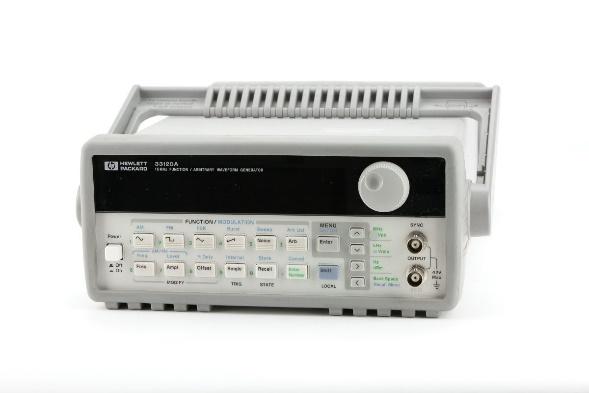
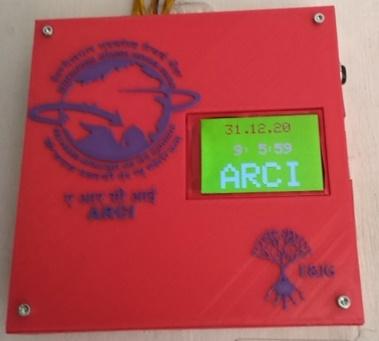
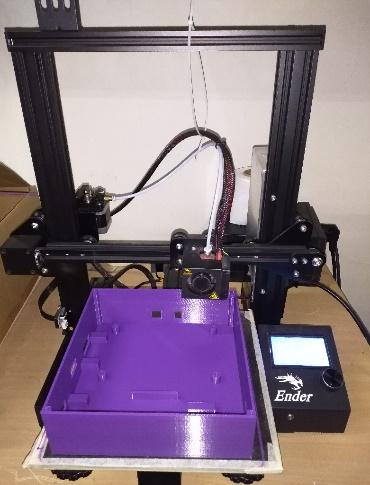
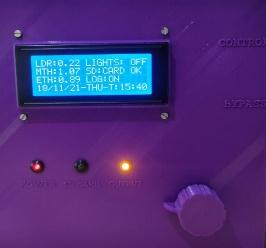
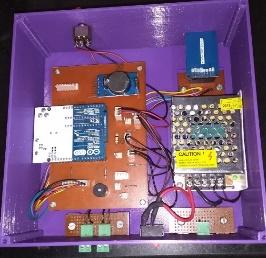



.jpg)


.jpg)










